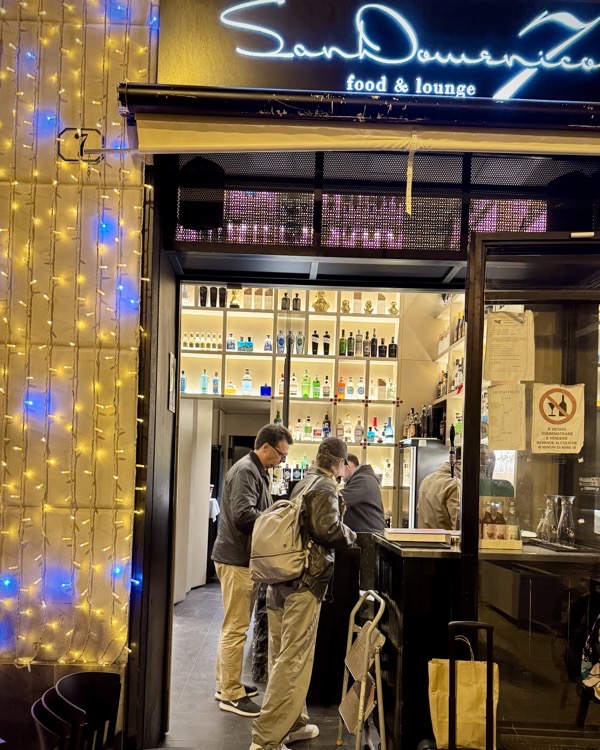Trip to Sicily. Day 1. Palermo: Ballaro Market. Palermo Cathedral. Marina.
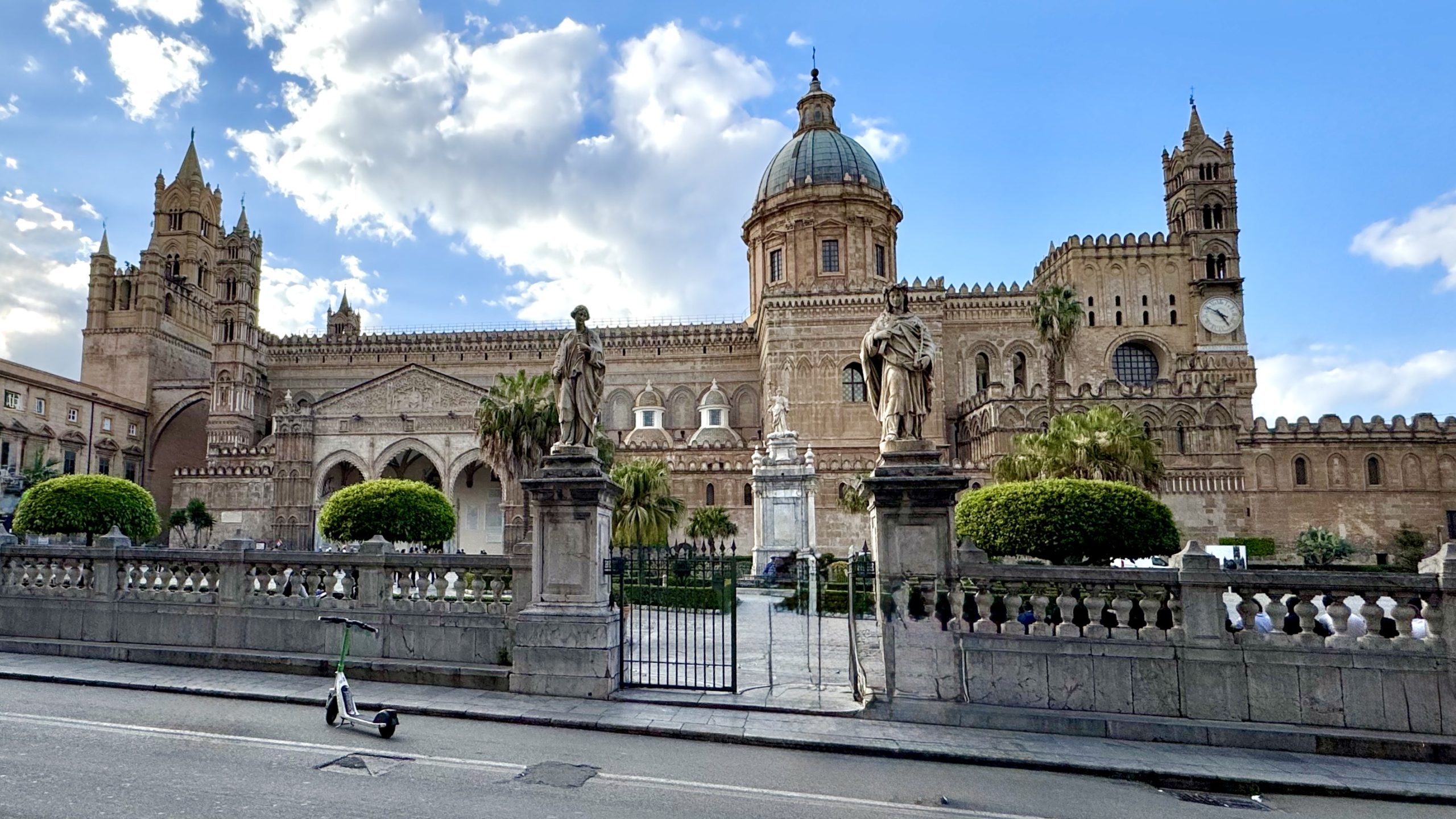
Day two in Sicily started slow. We slept in without tracking time. It was nice not to have any plans and enjoy the time, the open balcony, sounds coming from the street, slow shower.
Our affittacamere had four units. Three of them were vacant. If you’re reading these notes, mark your calendar — March seems to be a good time to visit Sicily: beautiful weather and easy accommodations.
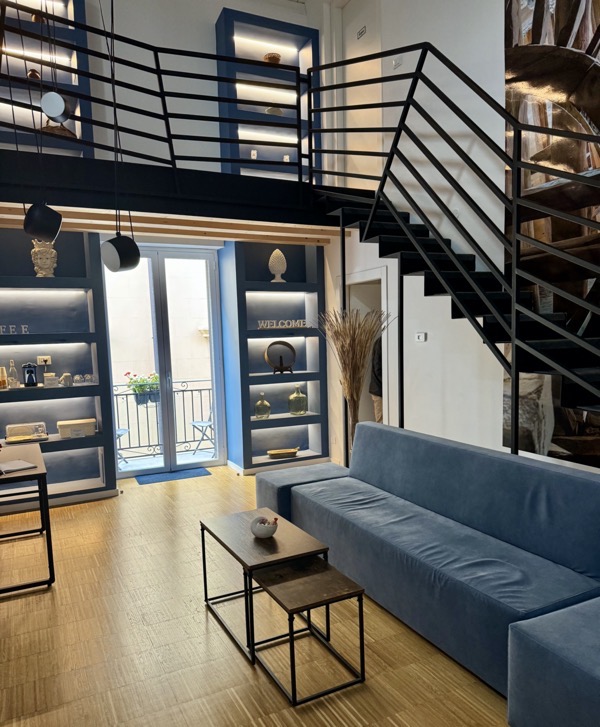
Hidden modernity among the ancient cobblestones. These boxes, each with a unique code, were there to leave the unit keys and eliminate the fear of losing them or having them stolen.
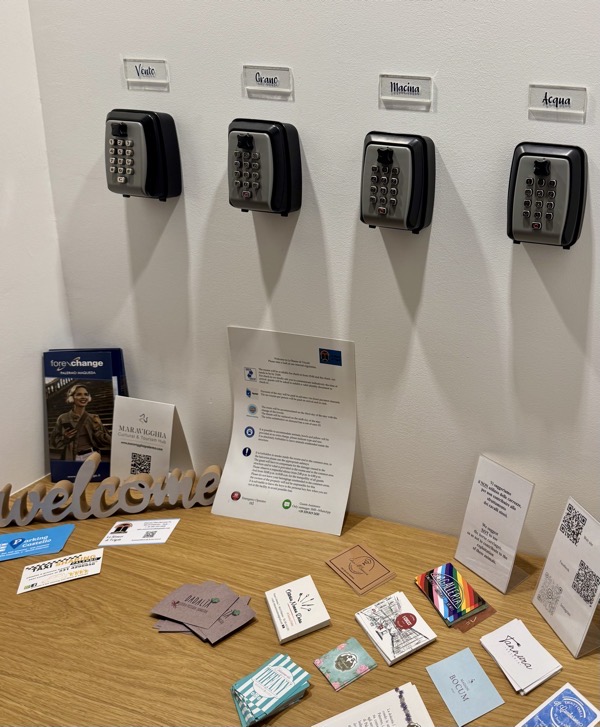
This is a long and slow staircase from our room to the street. We first encountered it in the dark on the way up and it felt endless and mysterious. Not as endless on the way down in the morning but still mysterious and beautiful.
Oblivious to the time, at the center of almost empty Vucciria I felt rested and excited that my day was just beginning. Honestly, even now I have no idea what time it was when we got outside. Maybe Tom looked at the clock but he did not tell me anything.

It is now I realize that street vendors on Piazza Caracciolo were wrapping up for the morning. For me then, it felt like they were just setting up and it was exciting.

First things first — breakfast. Epic Sicilian spleen sandwich Pani câ Mèusa introduced by Jewish street vendors a thousand years ago. For this sandwich, the offal was boiled and served with lemon and salt. Truly when the ingredients are good there’s no need to doctor them with spices.
At about the same time, Sicilian Arab population was enjoying bread with ricotta and caciocavallo cheese.
These two street food traditions morphed into a sandwich served in Palermo to this day. Boiled spleen, lung, and trachea are fried in pork lard and served on vastedda, a soft bun studded with sesame seeds.

There are two kinds of Pani câ Mèusa: maritatu, or married, offal with cheese and schettu, single, just offal alone. We got schettu probably because it was late in the morning — was it really still morning? not sure — and our vendor was out of cheese.

If back then I knew that it would be the most memorable meal of our trip, we would have definitely ordered a large one. But always expecting to try more and saving space we got a small one. The vendor shook his head in disapproval and right he was.
Frying in lard gives the meat the most incredible softness and that final touch of salt and lemon juice just bursts the flavors in the mouth. The sandwich is filling but, honestly, you’d want this memory of flavors and textures to linger.

Crossing Via Roma. Tiny Italian cars and motorcycles. Just like in Taipei a couple of years ago, they are the reminder of how we take space for granted in the United States.

A stop at Sant’Antonio Abate, a 13th century Roman Catholic church built in Baroque traditions. The church used to be part of the wall defending the city but, later, reconstructed many times to give ways to new streets and changing city landscape.
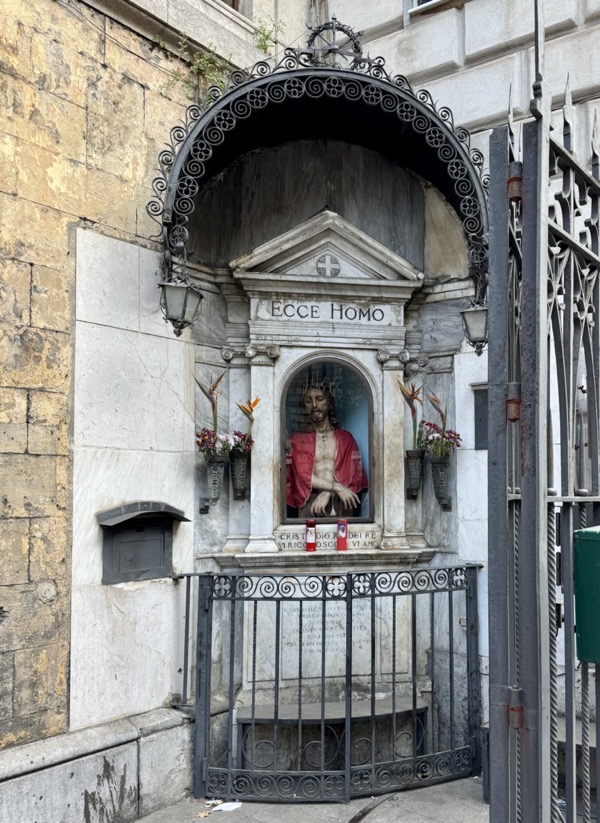
I would probably consider myself a Northerner by birth and upbringing. Oranges rolling on the ground just like that will forever fascinate me.
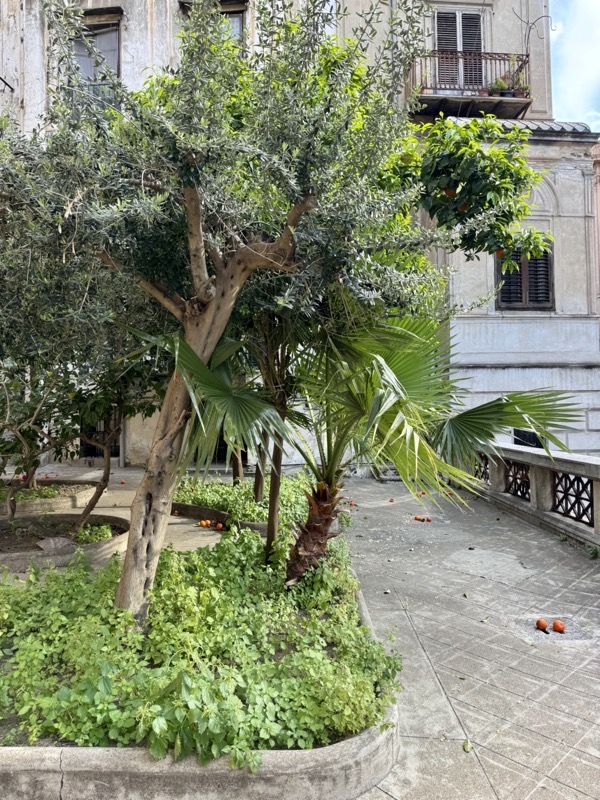
The Saint Anthony church is adjacent to the Vucciria market and we got a good view of our sandwich vendor and whatever was left from the morning activities.

Back onto Corso Vittorio Emanuele, past the Church of Saint Catherine. Now in daylight.
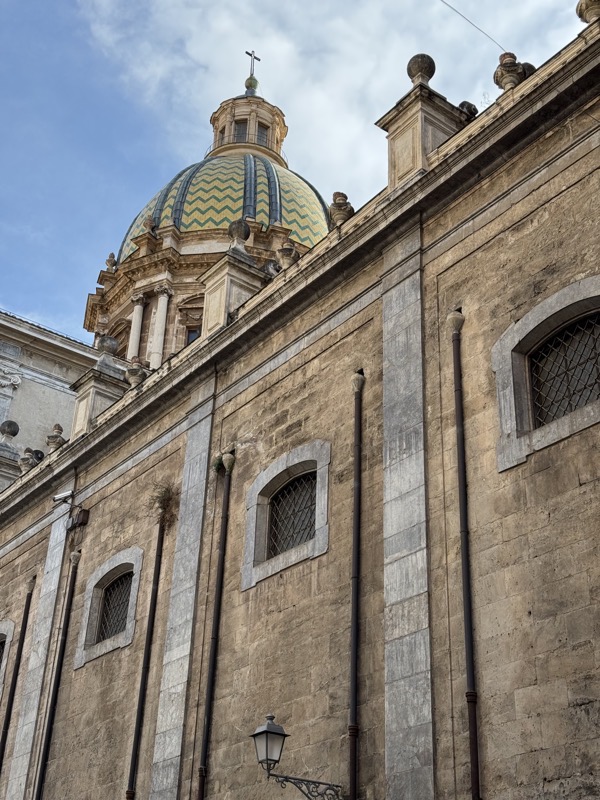
Back to Quattro Canti, The Four Corners, at the intersection of Corso Vittorio Emanuele with Via Maqueda where four historic quarters of Palermo collide.
North West corner has the fountain representing summer at the ground level, King Philip II above it, and Santa Ninfa, a patron saint, at the top and Seralcadi Quarter behind it.
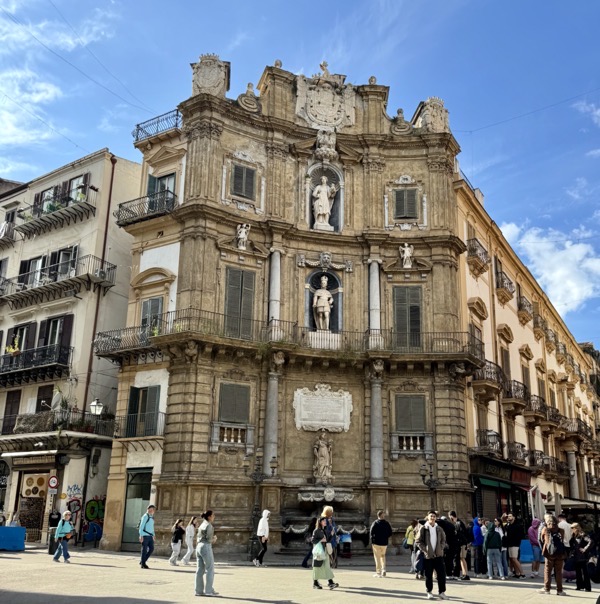
At the base of the North East corner that represents Castellamare Quarter, there is an autumn fountain, Philip III above it. Then — Olivia di Palermo at the third level.

South East corner is winter with Philip IV and Sant’Agata in front of the Kalsa District.
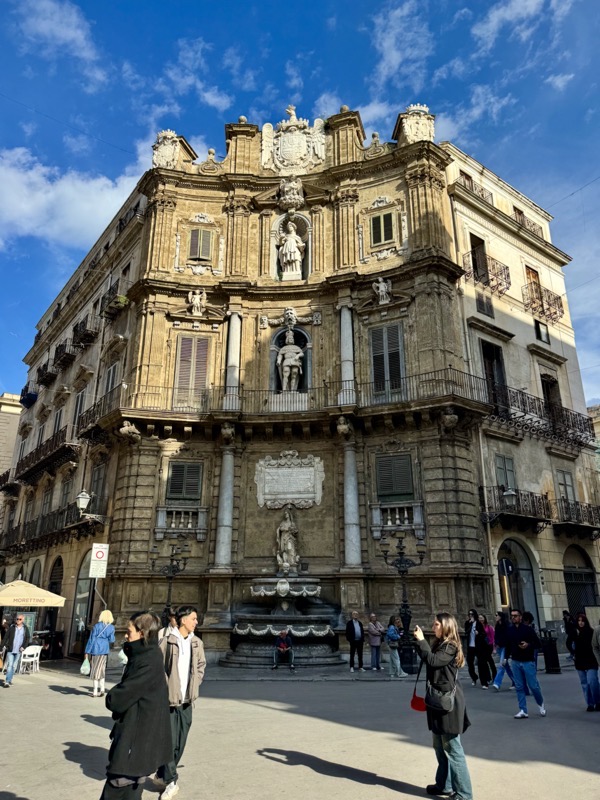
The last, South West, corner is spring with Charles V and Christina in front of Albergheria Quarter.
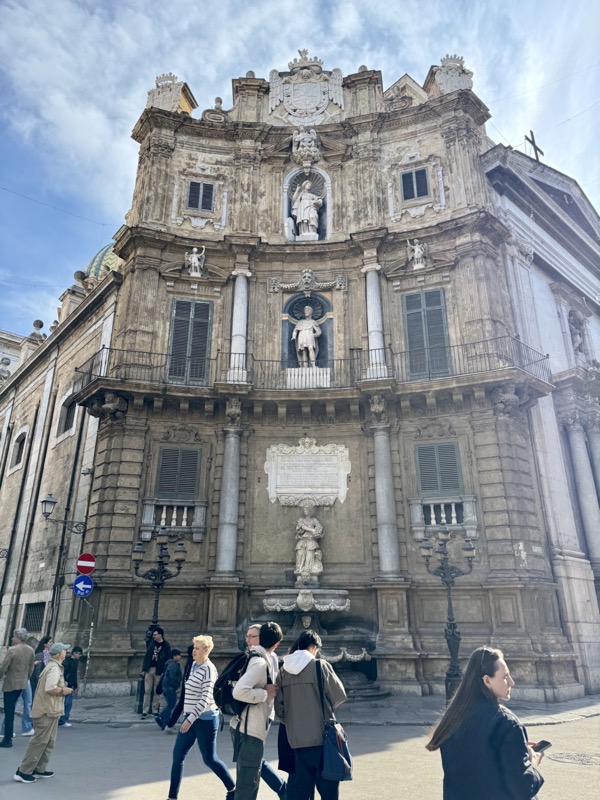
We continued along Corso Vittorio Emanuele towards our possible lunch destination.
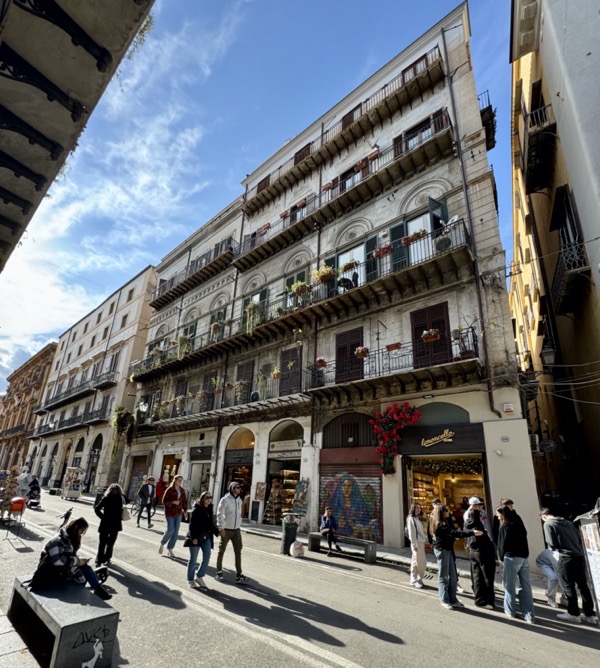
As we walked along, little adjacent streets spilling into the main street were a constant attraction to my camera and I kept snapping the pictures just for the mood of them.

Piazza Bologni, the oldest square in Palermo with the statue of Charles V in the middle surrounded by historic buildings.
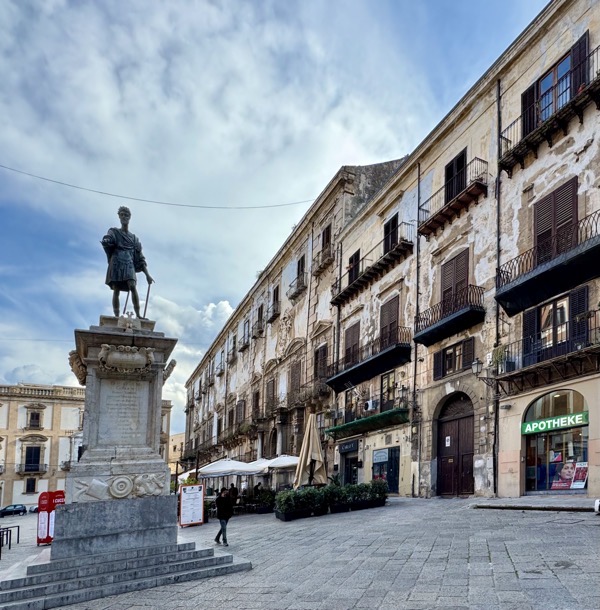
Shortly after Piazza Bologni, we got off the main street and moved south, towards the Ballarò Market.

Cobblestones are pretty hard on your joints and require constant attention as they are quite uneven and some of them could be missing or broken.
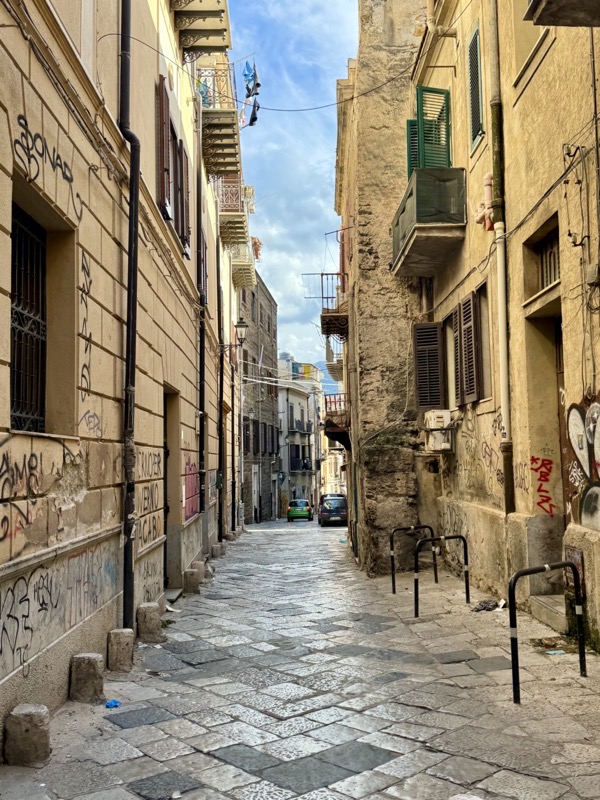
Constantly looking the camera lens, I would be long lost in the maze of these little streets. Thankfully, Tom is always alert and watching a map on his phone.
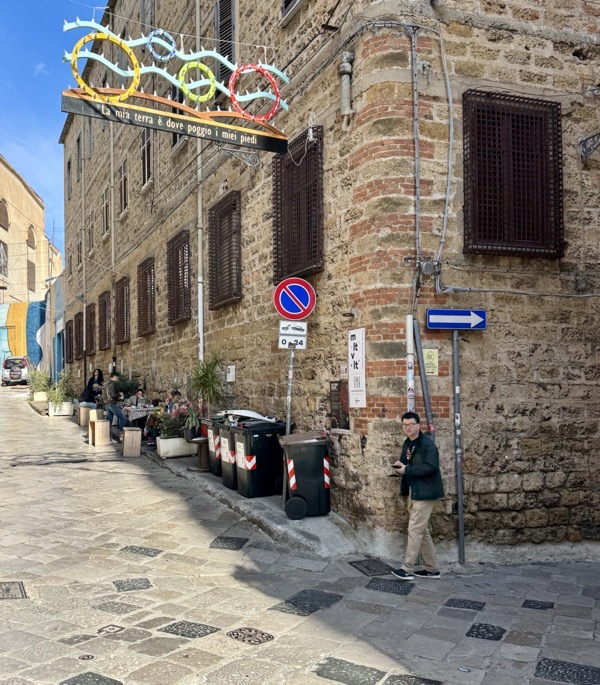
Here’s Via Ballaro, the road to our lunch.
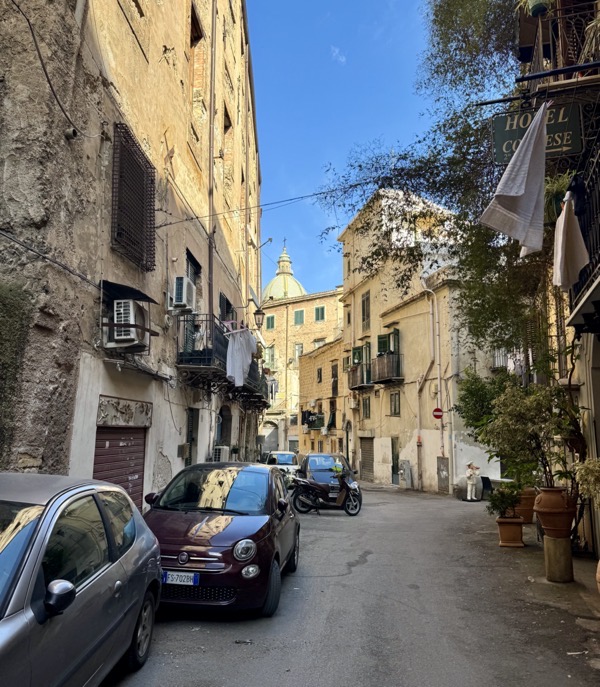
The Ballaro Market is named after the nearly village Bahlara, where most of its Arabic merchants reside and where the goods come from. This is the largest outdoor market in Palermo. Some references say it might be a thousand or more years old. Instead of coming here early in the morning as all the travel guides advise, we came really late and the crowds were already quite thin.

Last night this area looked quite different — dark with silent shadows lurking around; it didn’t even feel safe. Today was a different story. Even though we got here in the afternoon with trade winding down, the place was lively and traders actively pulling you in to buy what they offered.
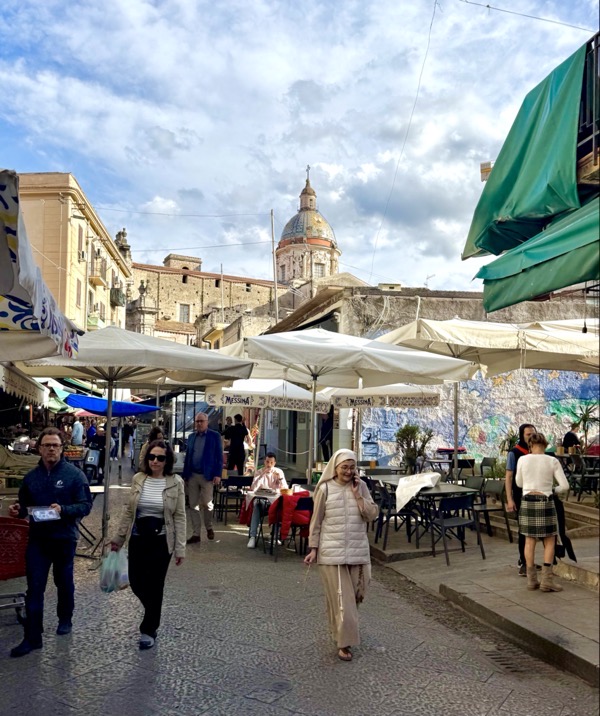
Someone said that to feel a country or a city, you need to visit a railway station, a cemetery, and a market. Not sure about the first two — sometimes, but the last one is definitely my favorite go to place.
Foreign markets are simple and wondrous at the same time. Like this counter: sliced grilled vegetables. How much more simple can it be? But then how often do we get to experience vegetables grown in a real soil under the sun, cooked with locally grown herbs. Terroir factor makes simple things unique.

Our walk through this market was definitely a highlight of our stay in Palermo. Although in the afternoon, we still got to experience the colors, the smells, the screams and music of this place.
My first encounter with salted capers piled on a tray and in such a quantity. I paused here for a while as all the possibilities were floating through my mind.

Graffiti, the hassle of the market and stunning Chiesa del Carmine Maggiore, The Church of Carmine Maggiore, in the background. Its origins go back to the 13th century when Carmelite friars started to arrive in Palermo from Mount Carmel. What makes this church stand out from the others in Palermo is this colorful dome decorated with maiolica tiles supported by the statues of Atlanteans.

Moving along the market lanes, absorbing the contrasts of the architectural beauty with the realities of the everyday necessities. Quite picturesque, in its own way, a meat counter of Ballaro. For a carnivore like myself, It is a beautiful sight.
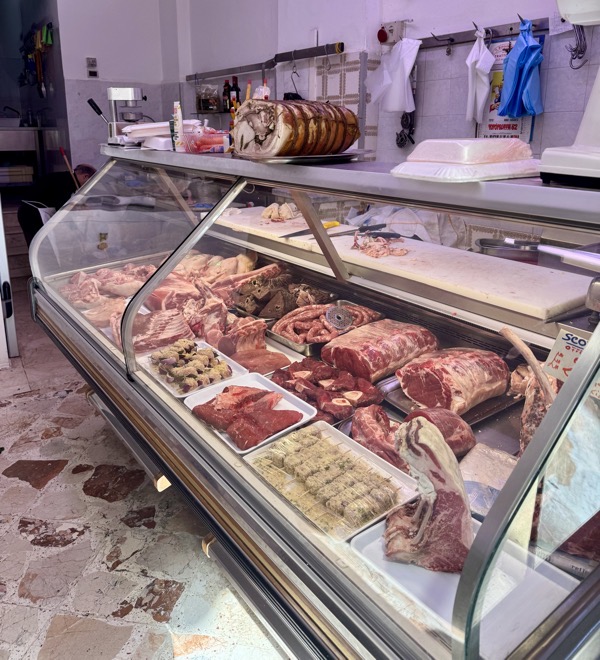
These beautiful but unkempt sides streets reminded me of Moscow during the wild 90s — same history in the need of so much TLC.
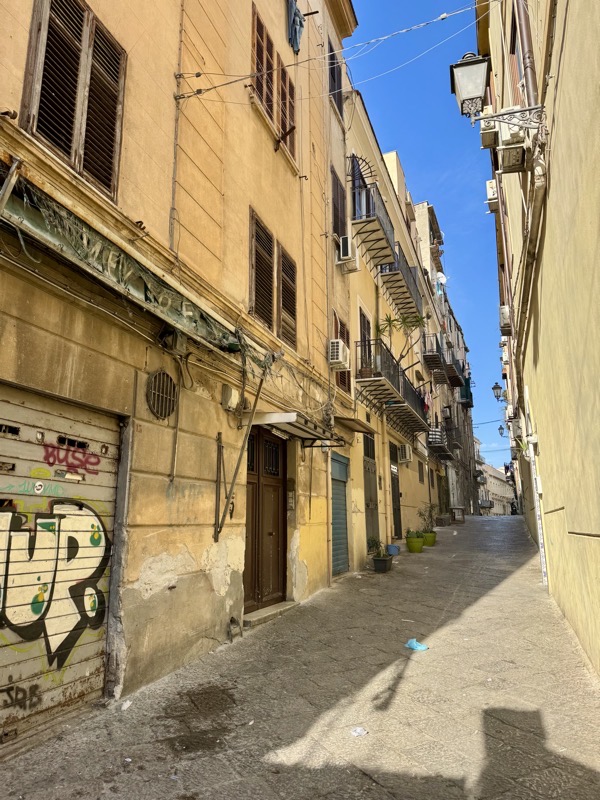
Chiesa del Carmine Maggiore dome a little bit closer. That’s how you roll in Palermo — between exquisite beautiful history and not much taken care of current modern reality.
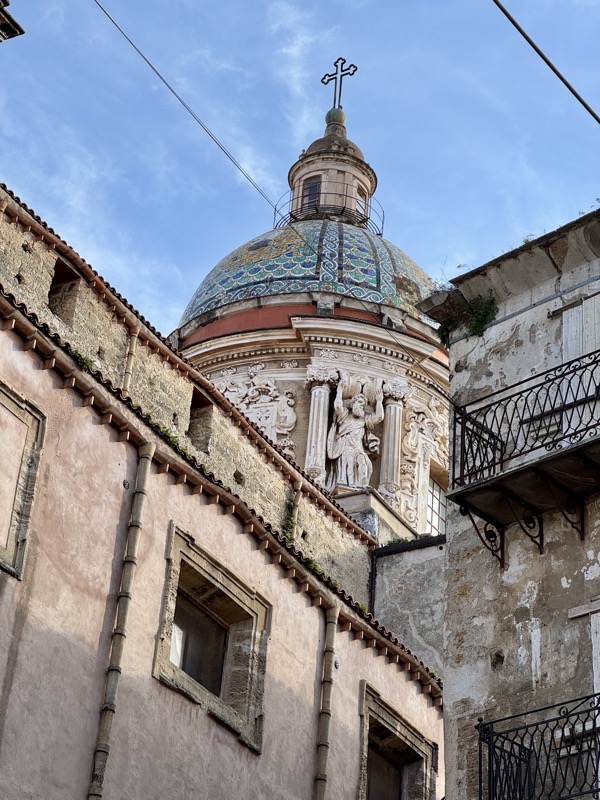
Proceeding further into Ballaro Market — colorful and forever attractive piles of seafood.
This is when the reality of time started to sink in for me —obviously someone was here before and cleaned up a good amount of shrimp and oysters.
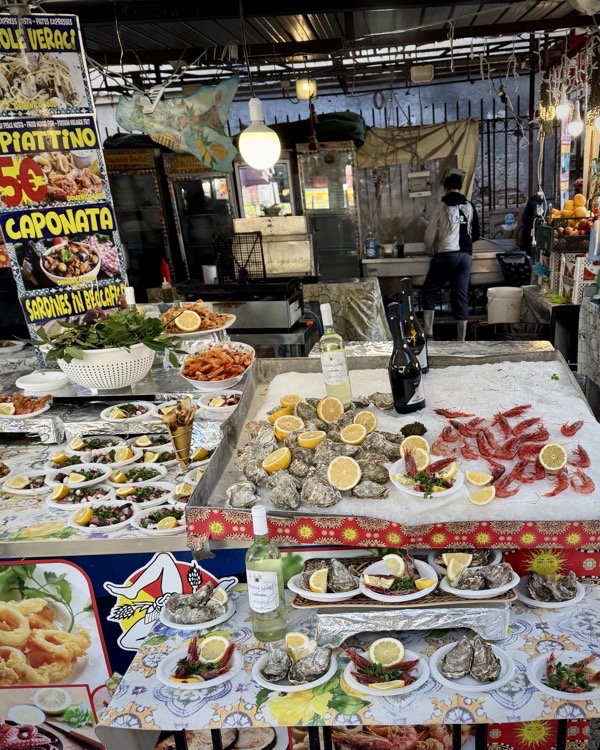
Passing by the Aperol stand, I looked at my watch. Shocking! Until this moment I did not realize how far into the day we were. It was already 4 PM. Jet lag is jet lag. On the bright side — we can have a drink breakfast without guilt.

Polpette di sardine e carciofi marinati. That was our lunch. After a trip to China, language barrier in Italy was barely noticeable. Same alphabet, familiar words. And someone who has read a few Italian cookbooks feels here even more comfortable.
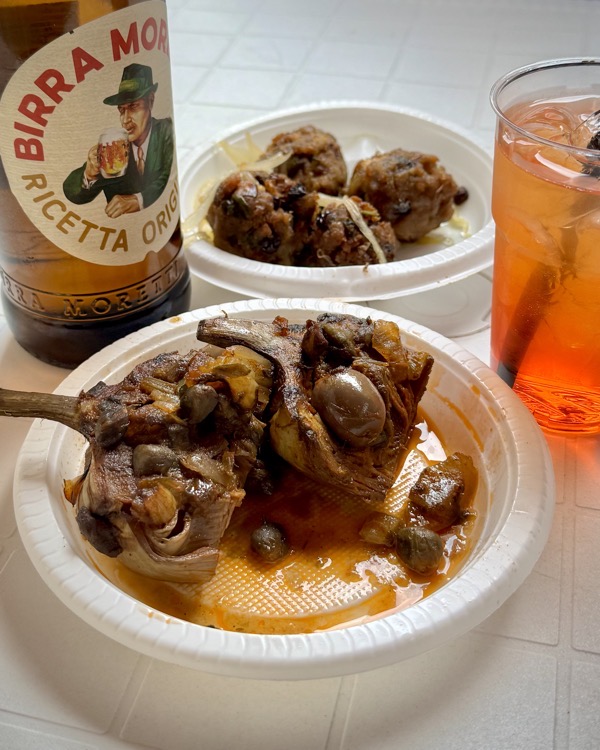
Activity around our counter has been already folding but while Tom was ordering our drinks I found a chair. One of the merchants noticed that and, boy, he created a fuss around us. People started bringing tables and chairs back, wiping them. Tom felt extremely uncomfortable that he was noticed and being served. Honestly, it seemed that these people genuinely enjoyed extra action, company, and just living the life.
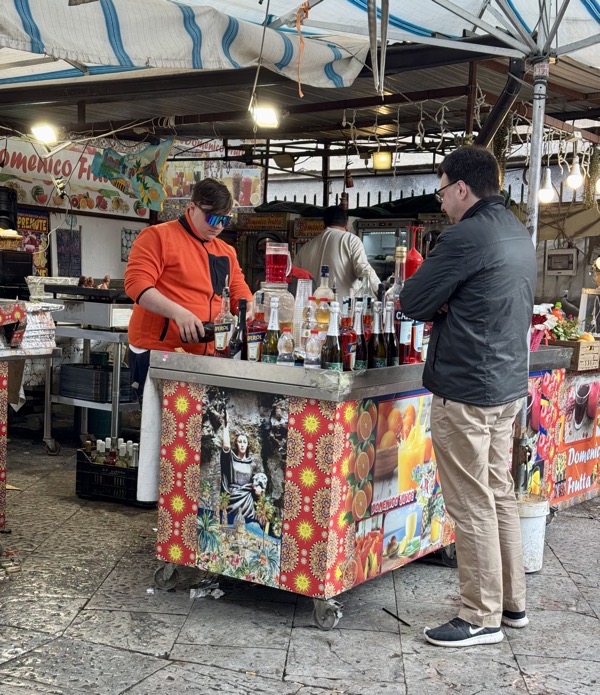
We sat there for a while gearing up for another walk and watching the clean up. How organized this seeing mess actually was — everyone knew and did their part, everything had its place.

All cleaned up. As Tom’s dad used to say: Julia is a very good eater, very good appetite. It is what it is.
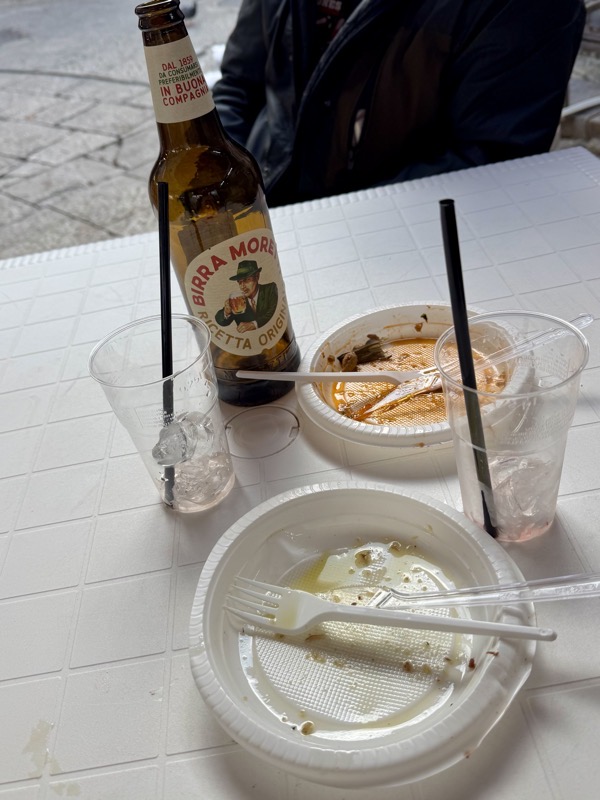
Rejuvenated by a snack, some beer, and a glass of Aperol spritz, we walked around Chiesa del Carmine Maggiore.
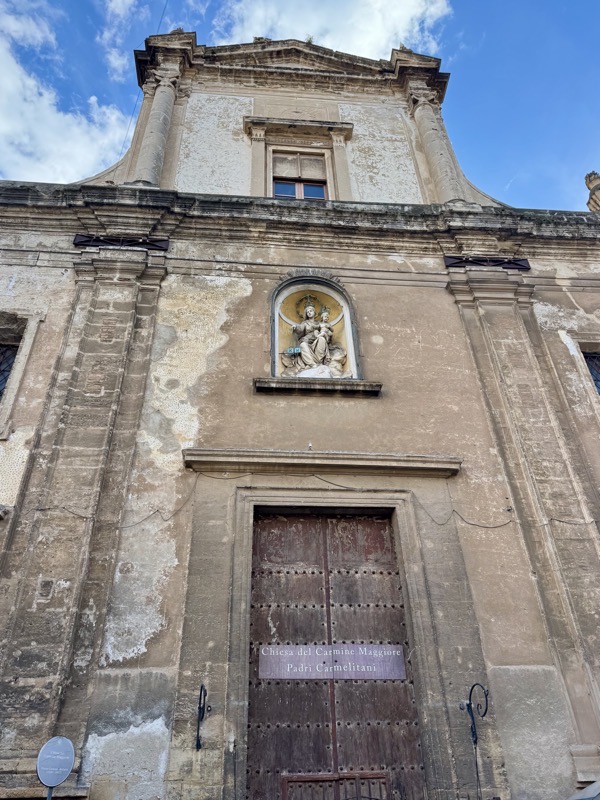
The trade around the market was seriously winding down.
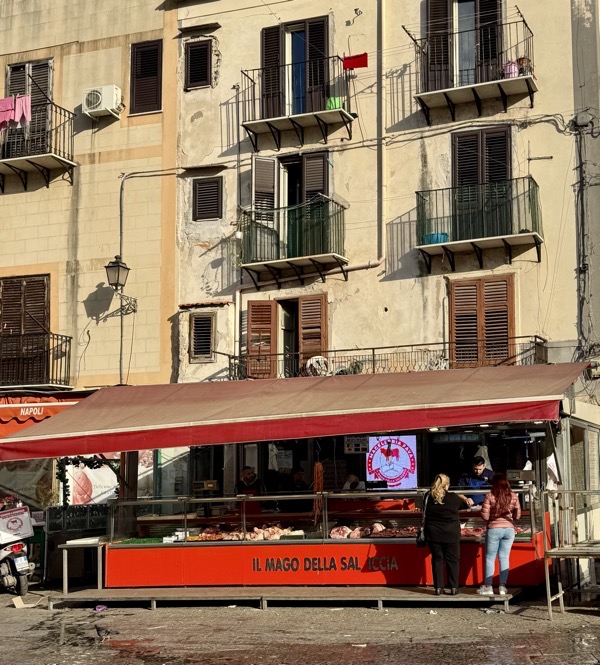
At the base of the church, locals have already been gathering for the afternoon winding down and drinks.

Some streets were already completely empty just like they were the night before when we wandered here in the dark.
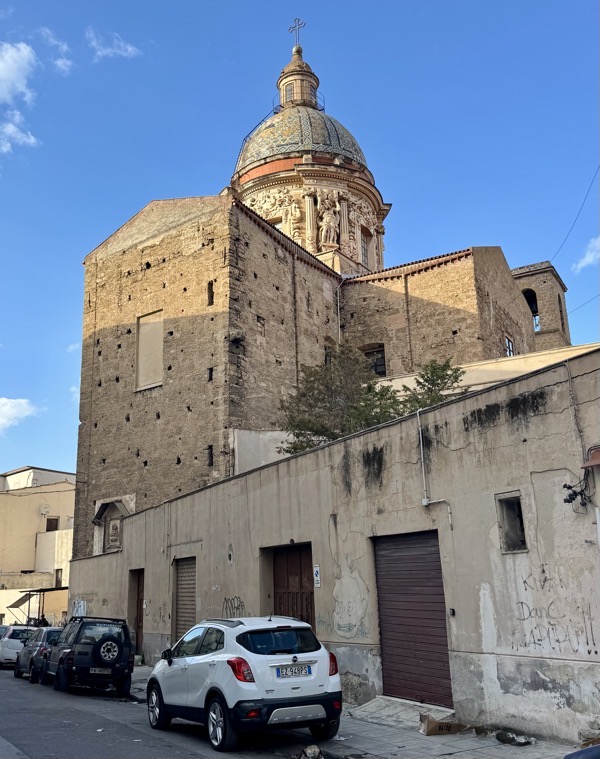
We moved along Via Giovanni Grasso towards the dome of Chisea di San Francesco Saverio, a Jesuit house built at the turn of the 17th century.
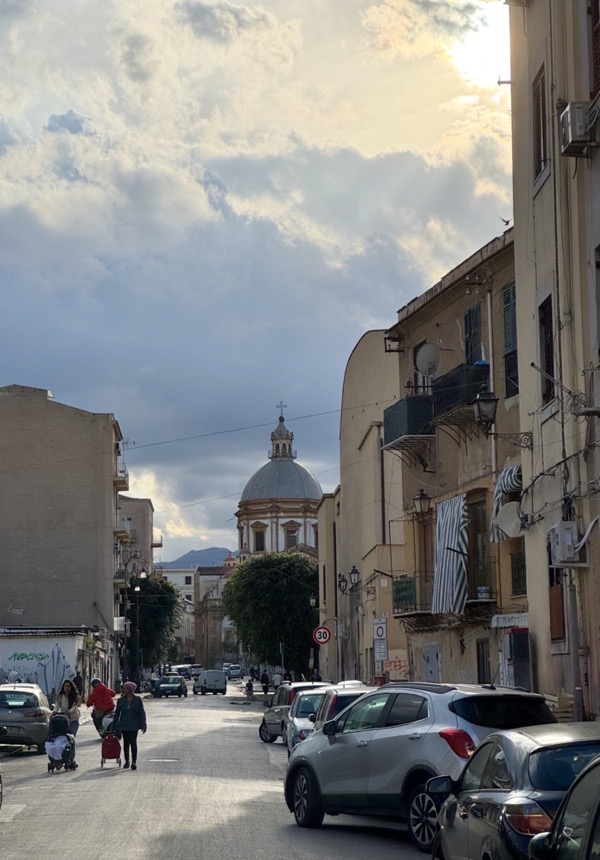
This church has been a house of worship, a seminary, a military hospital. These days it is a popular wedding venue.
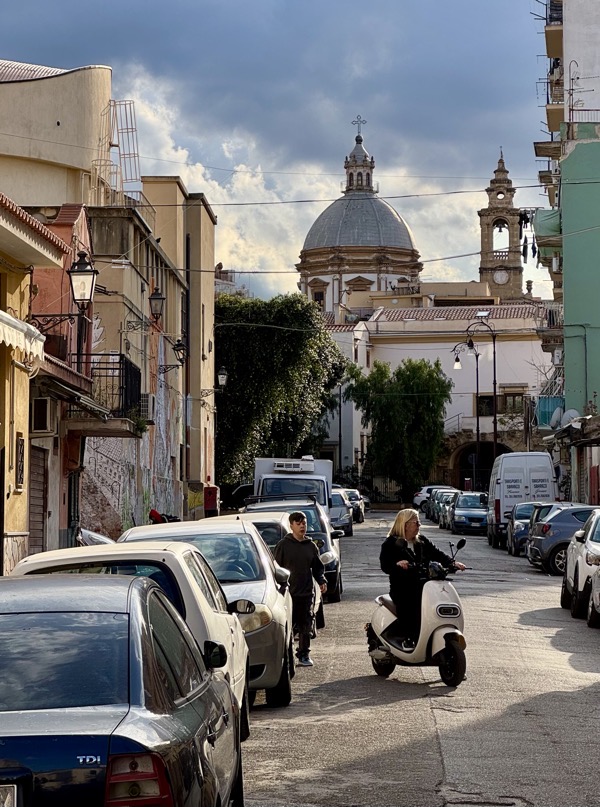
It is just now looking at these pictures I am trying to recreate our wanderings around Palermo. Tom was the guide. We both were glued to the phones. He was following the map and I was trying to capture every feeling.
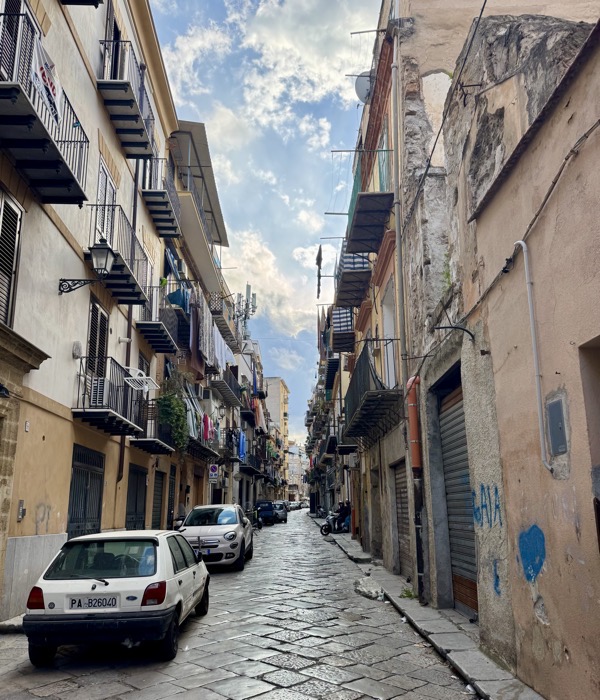
Of course, at this time, it is not possible to recreate the names of all little streets and piazzas we crossed but my hand does not rise to delete pictures no matter how meaningless they might look.
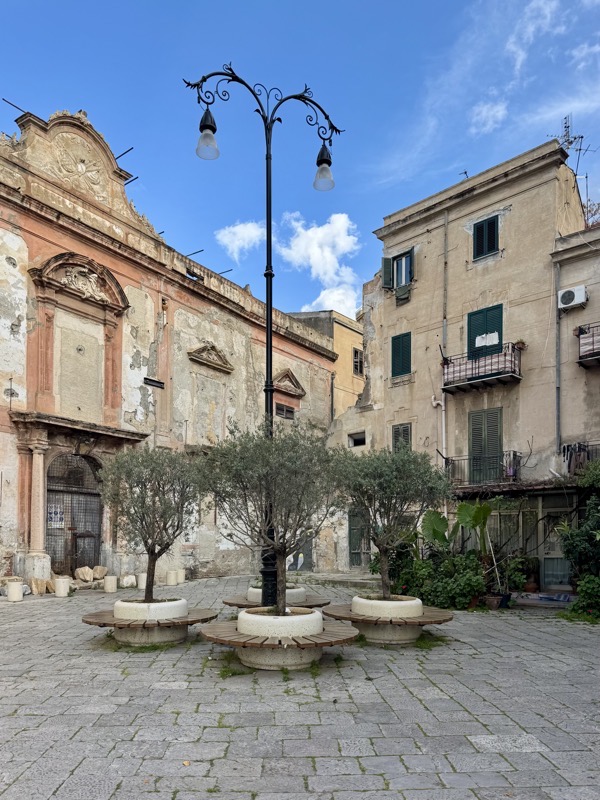
One thing Palermo is famous for is graffiti. Some of the urban street art works relate to the city’s history, some cover mafia. You can even go on special graffiti tours to catch the work of some top international artists.
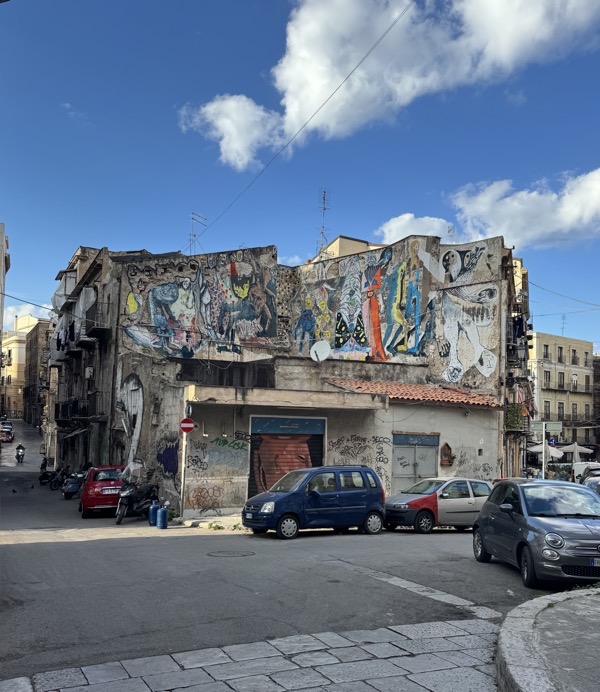
As we walked, on every street here and there was an opening offering drinks and snacks. Nothing fancy — a couple of tables outside or just stools — where one can land for a panini, some beer, or Aperol.
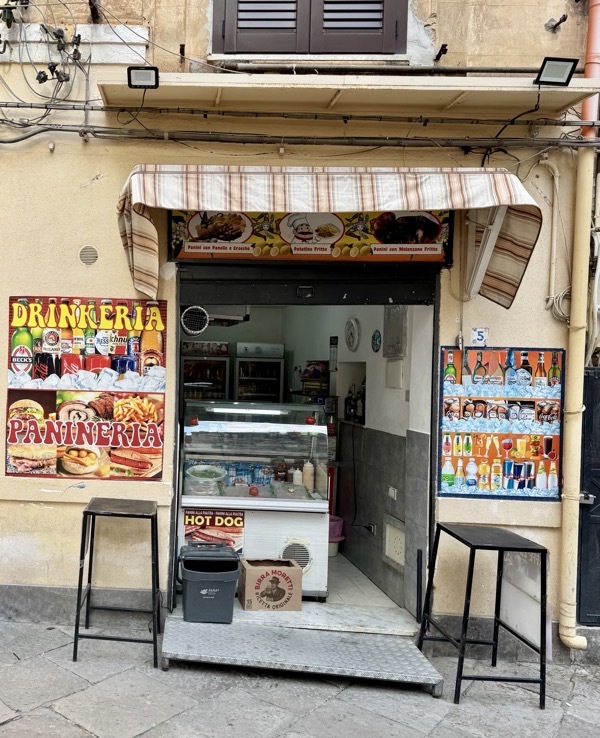
Vicolo Conte Cagliostro. Legend has it that in this alley once known as Via della Perciata in the 18th century lived a notorious impostor Giuseppe Balsamo, known as Count Alessandro Cagliostro. A self proclaimed healer, magician, and psychic, he traveled all over Europe cashing in and gathering some serious wealth pulling noses of the rich people with his “supernatural powers.”
He even made a trip to Russia, where he tried to sell a fraudulent formula of love to Russian nobility but almost got caught.
Back in the Soviet Union, a movie director Mark Zakharov made a musical comedy based on the Alexei Tolsoy’s novella “Formula of Love.” The story was about the trip when Count Cagliostro, on the run from Saint Petersburg nobility, in the middle of nowhere Russia, tried to bring to life a statue which one young provincial aristocrat happened to fall in love with. The movie was wildly popular for its actors and music. In my wildest dreams, I could never have imagined that I would be standing on the street where the Count was born and lived.
That black oval once held a metal image of the Count but it was dismantled and stolen. They say thieves used a ladder to take it down.
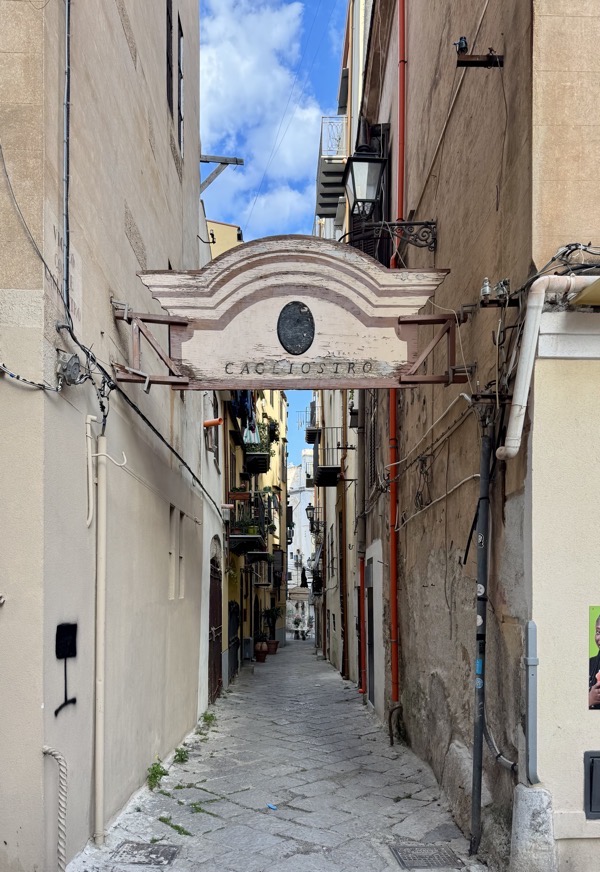
Moving closer to the center of the city and seeing more Aperol, fruits, and Pani câ Mèusa carts.

Traditional Sicilian handcrafted jewelry, of course — bobbin lace, silver, crochet, pottery, tatting. Temptations on every step of the way.
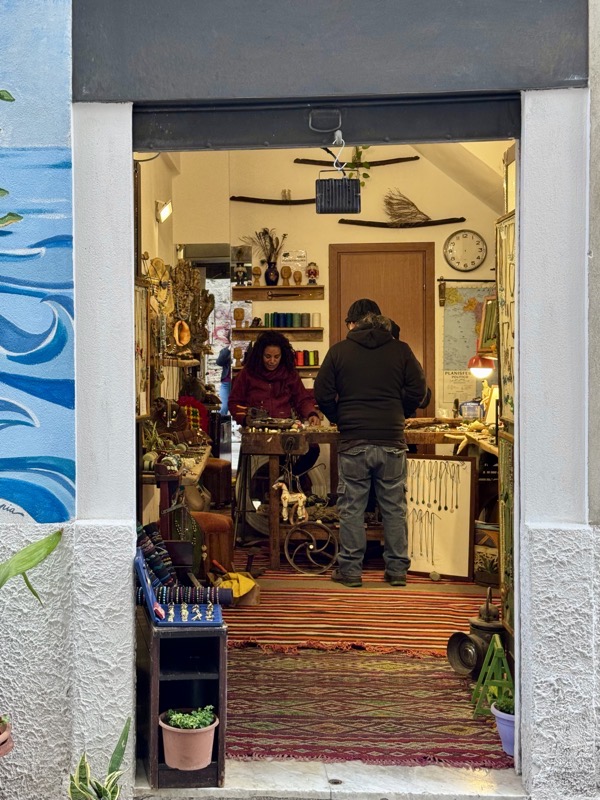
Winding through the graffiti covered walls of Palermo, Tom was working our way towards Palermo Cathedral.

Via Matteo Sclafani, named after a powerful baron known to build multiple palaces and cathedrals in Italy, and Palermo in particular.

Via Scafani flowed over into Vivolo di Brugnò, a narrow alley, which is a must visit in July during the Feast of Santa Rosalia, Palermo’s patron saint.
Every year, in July, in this tiny alley, its residents create an altar with a statue of Santa Rosalia. For about ten days during the Feast, the walls of this street transform covered with lights, photographs, paintings, sacred relics — different each year.
There is even a legend how this Festival started after one day, about sixty years ago, a resident of this street was hospitalized with a serious illness. Incredible recovery of that resident is attributed to the prayers addressed to the Santuzza Rozalia. In gratitude, that resident once released from the hospital bought a large statue of the saint and donated it to the alley. Every year, in July, the statue is taken outside for a display and the alley becomes a place of pilgrimage to Italians and tourists alike.
This alley is so tiny and so well protected from any influence of modernity that it created a feeling that you’re almost entering someone’s home with clotheslines across distinctly present.
Older women standing the the archways of the street obviously were a tight knit tiny community and they gave us the once over, recognizing strangers. Wish I knew the language. No, wish I could stand there for a few more minutes to feel that time from the years gone by so carefully preserved in this tiny alley.
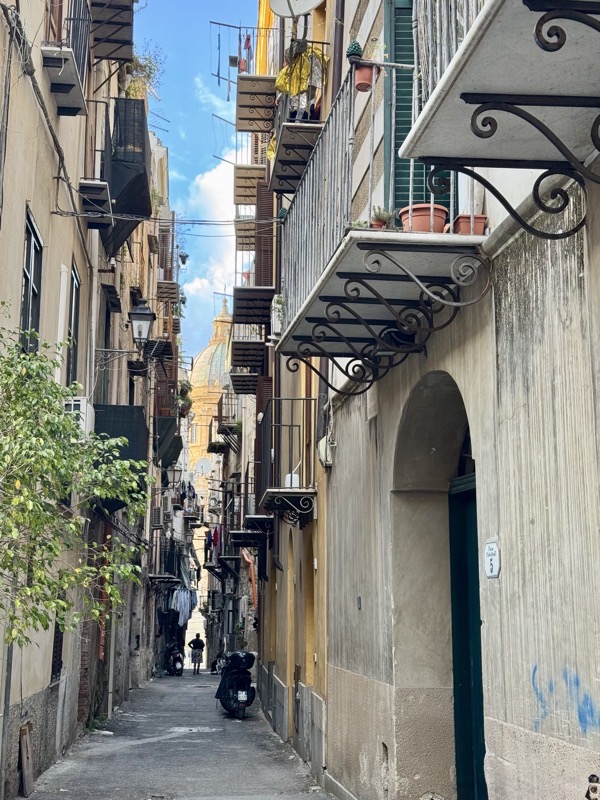
And here it is — Cattedrale Di Palermo — the symbol of the city. This Roman Catholic church stands on land that has been a place of worship since the 4th century, including a mosque that was here during the Arab times.

The official name of the cathedral is the Cathedral of the Assumption of the Virgin Mary. Over 700 years, the cathedral constantly underwent changes — alterations, explanations — and it appears to combine features — Greek, Roman, Arab, Norman, German — of whoever was in charge at the moment.
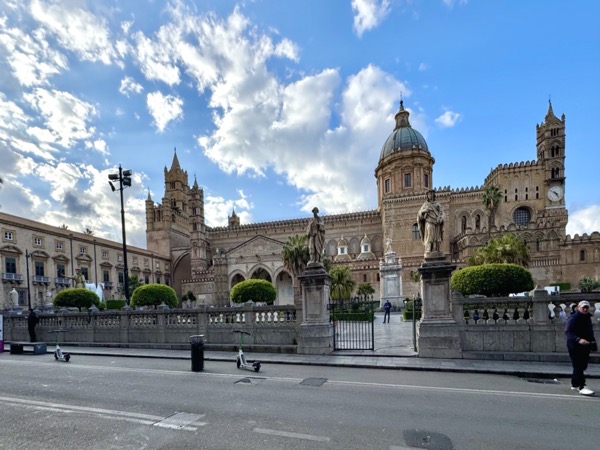
Right in front of the cathedral there is a statue of Santa Rosalia, or how she is lovingly referred to by locals, Santuzza, the little saint. She is the patron saint of Palermo. That creature at the bottom of Rosalia’s feet symbolizes defeated plague.
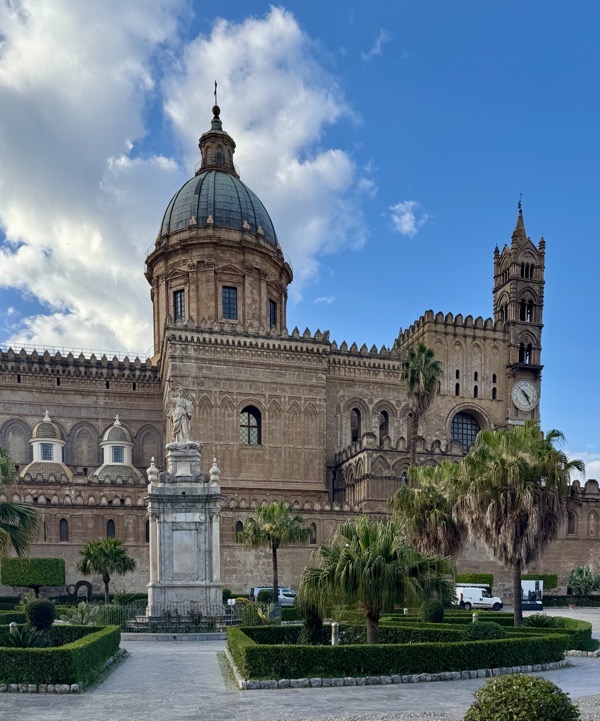
The Catalonian gothic arches are entrance to the cathedral.
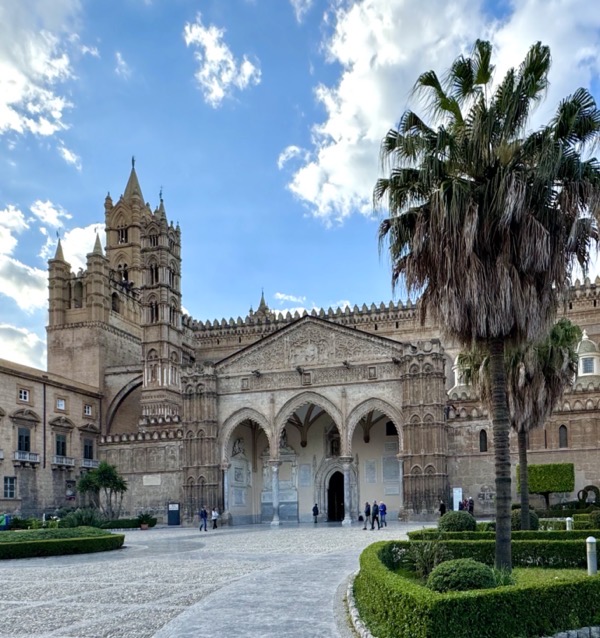
The cathedral was built on the site of a mosque and it was supposed to surpass the magnificence of its main rival, the cathedral of Monreale. This rivalry was known as “The Battle of the Two Cathedrals.”
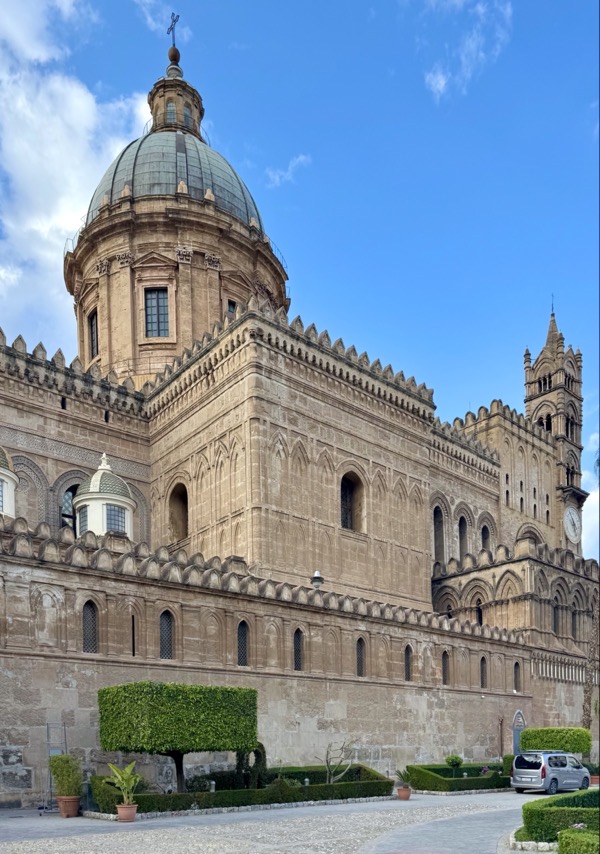
Although the main structure was built in the 11th century, this dome was added in late 1700s.
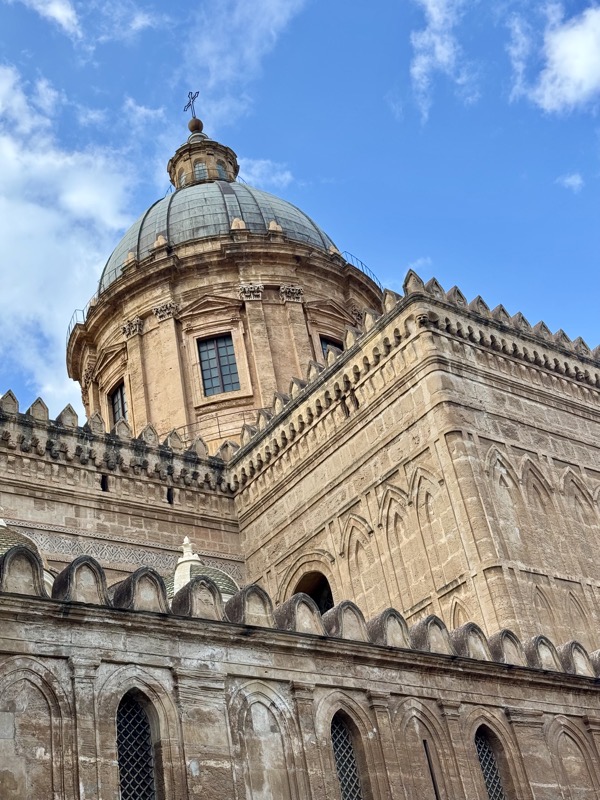
This font is supported by the sculptures of the Tree of Knowledge and Adam and Eve with Baptistery over it.
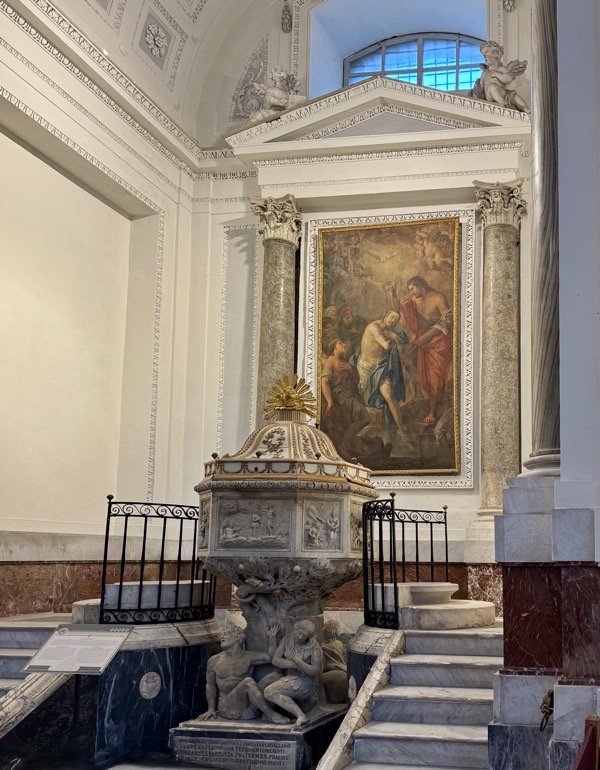
This is the view towards the main altar.
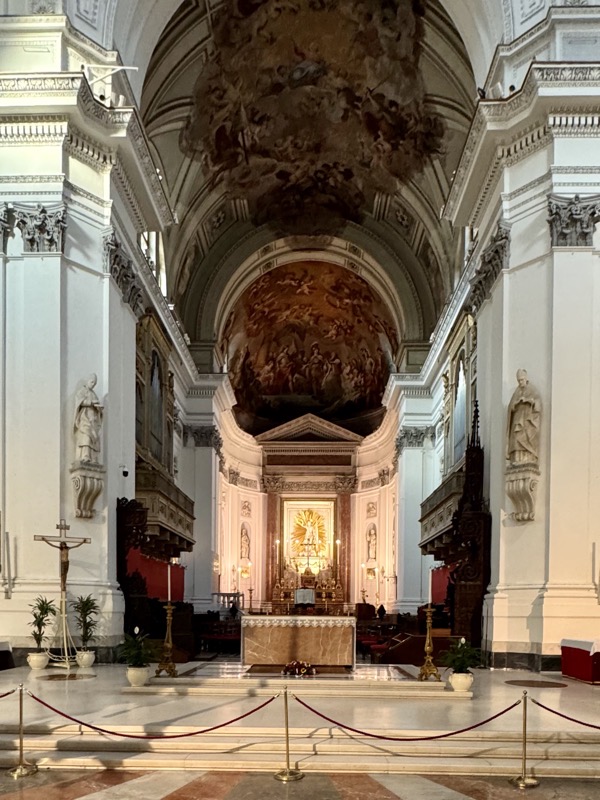
To the right of the main altar is the Chapel of Santa Rosalia.

Another side altar with the Crucifix.
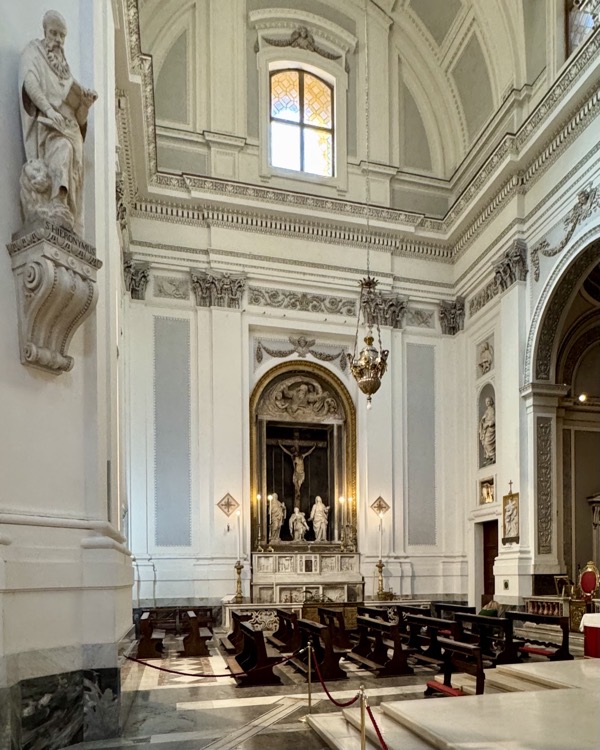
The altar and images of Santa Rosalia.

The 14th century wooden Crucifix with marble statues of mourners.

The side altar with the relics of Santa Rosalia.
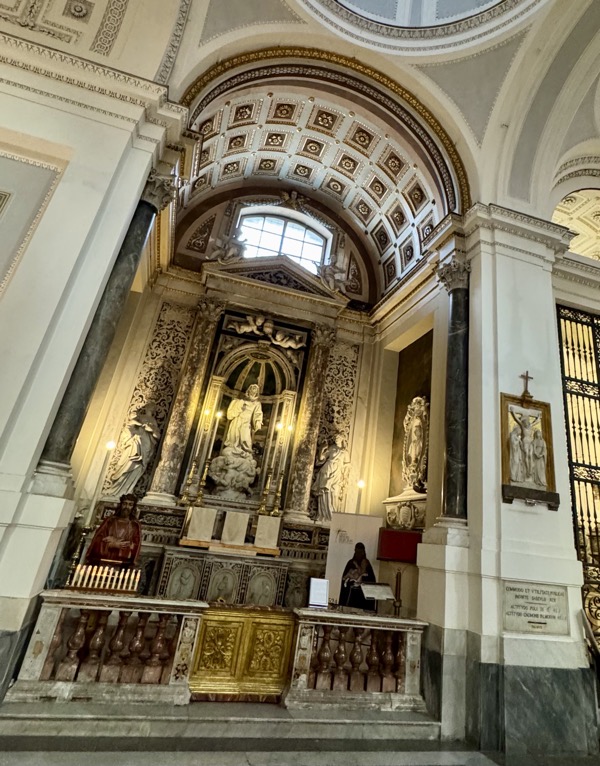
One of the central pillars.

The dome above the relics of Santa Rosalia is one of the last major additions to the cathedral.
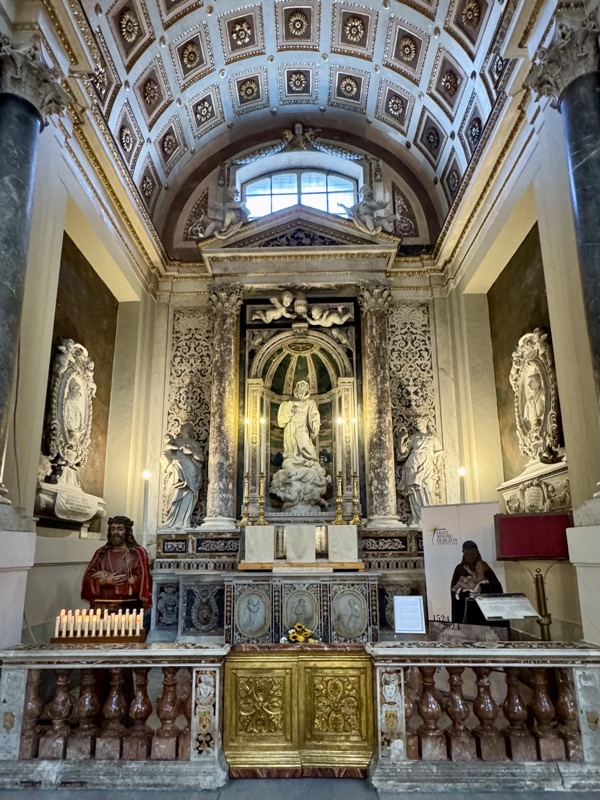
The Confession Booth.

The cathedral was the place of royal coronations and the place of the final rest for Sicilian Royalty.
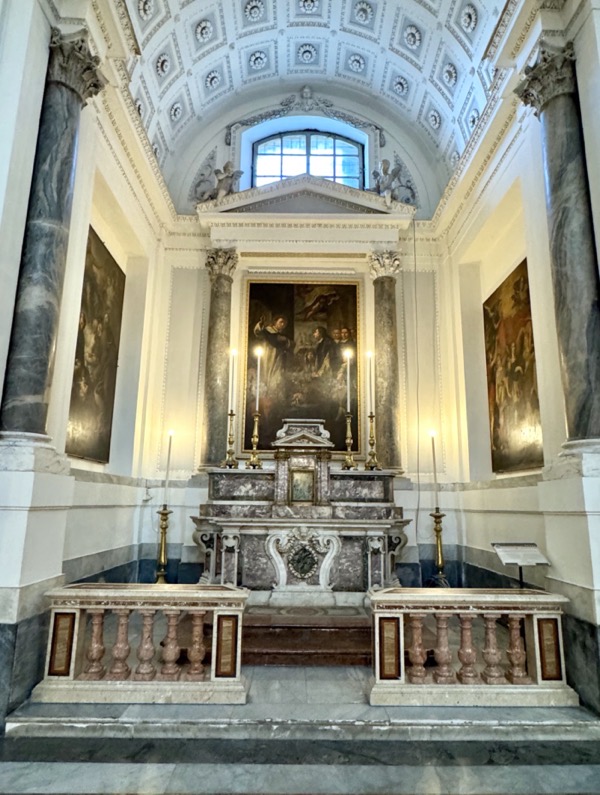
The Sundial of Palermo Cathedral was installed here by an astronomer and mathematician, who was also a monk. It is a marble slab running across the cathedral floor with paired up zodiac signs. It serves as a calendar here.
Capricorn.
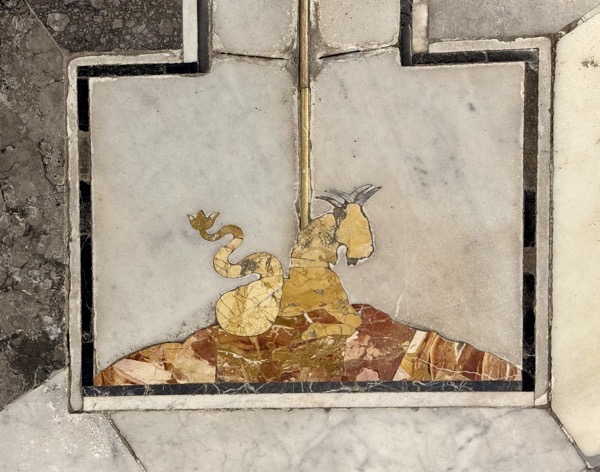
Sagittarius and Aquarius.
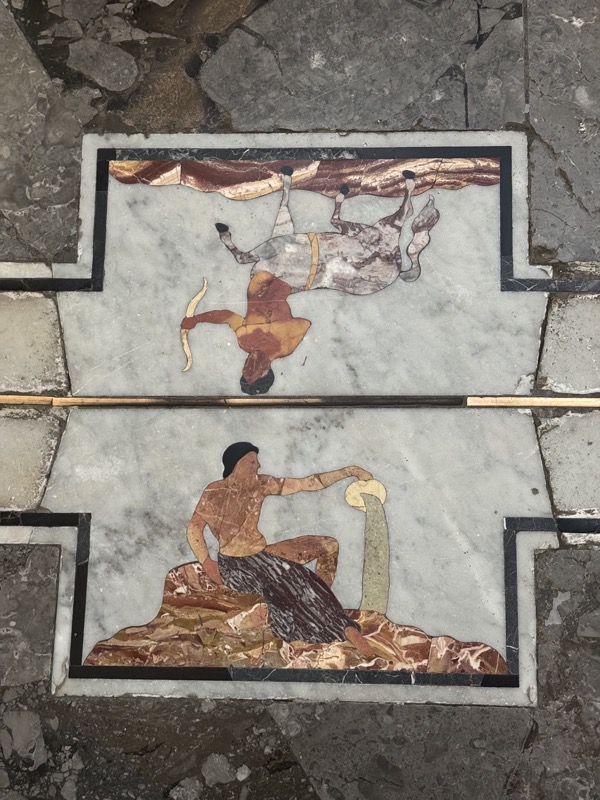
Scorpio and Pisces.
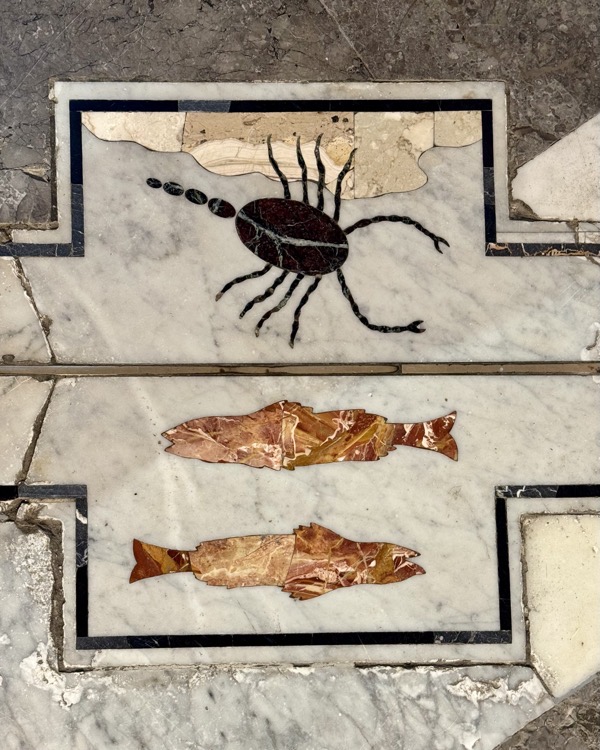
Libra and Aries.

Virgo and Taurus.
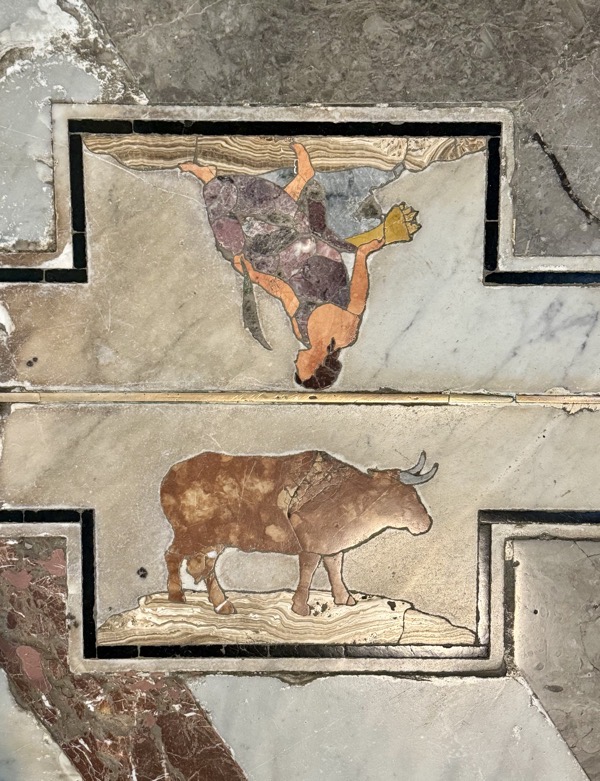
Leo and Gemini.

Cancer.
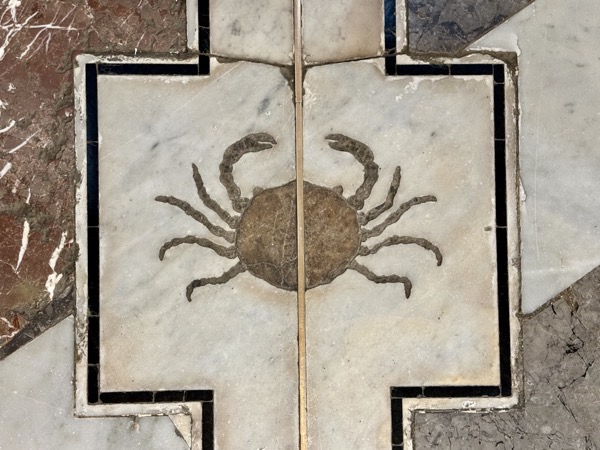
How does this sundial work? If you raise your head and look at the dome above the relics of Santa Rosalia, you will see a small hole. Sun shines through this hole on the floor of the cathedral. Angle of the light changes according to the current position of the Earth in relationship to the sun and points at a particular zodiac sign.
It was the end of March. At noon, when clouds parted, the sunbeam lit up the Aries.
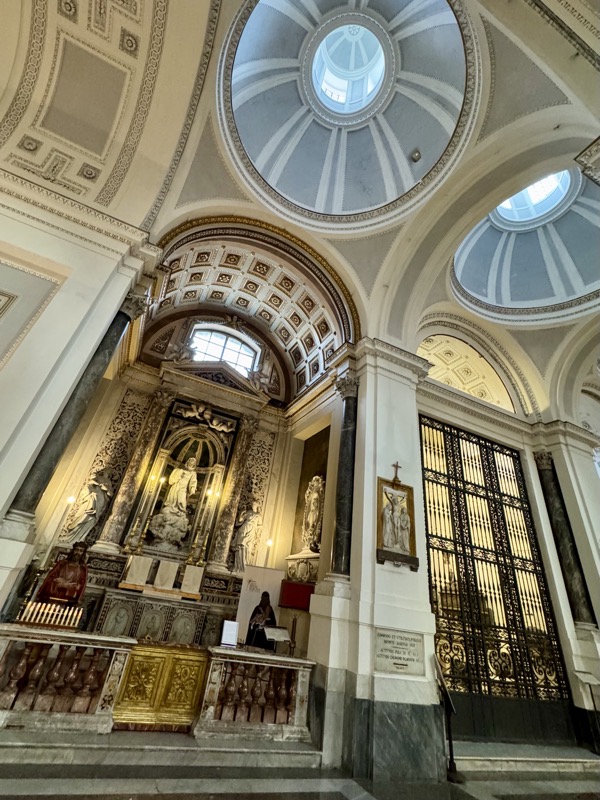
These two pointed arches connect the Cathedral with the Archbishop’s Palace making the whole complex look more like a castle rather than a church.
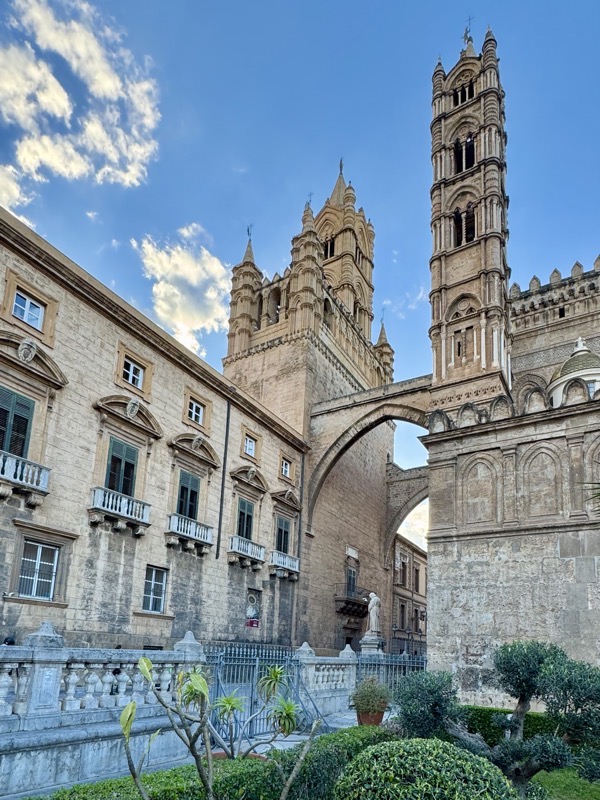
Statues of popes outside the cathedral create the feeling that you’re being watched.
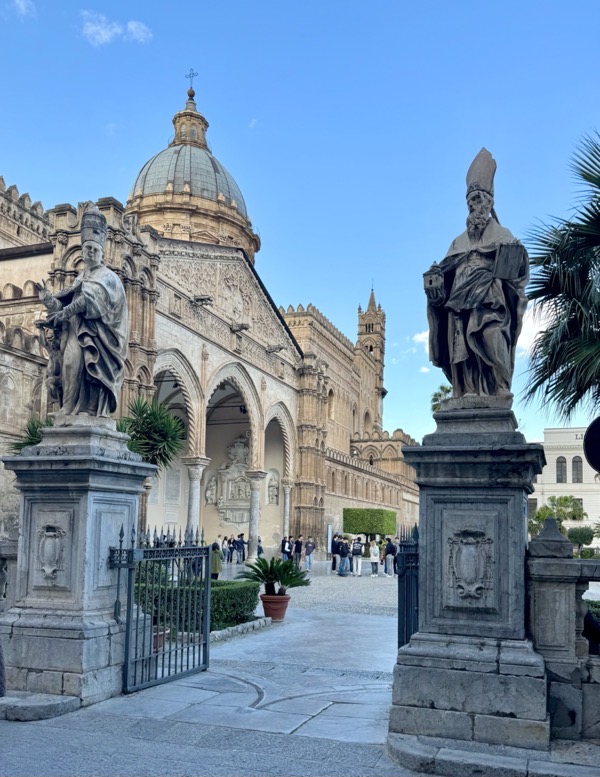
Porta Nuovo, New Gate, an official city gate of Palermo where Via Vittorio Emanuele flows into the oldest street of the city, Corso Calatafami.
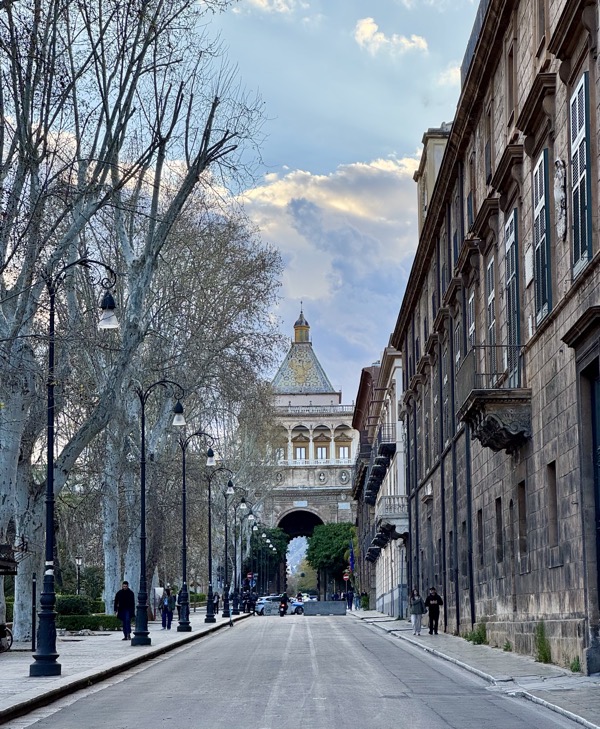
We slowed down outside the Cathedral with a classic Italian selection: Aperol, limoncello, mulberry granita, hazelnut gelato, and espresso. For those who know — even Tom had a shot of espresso.
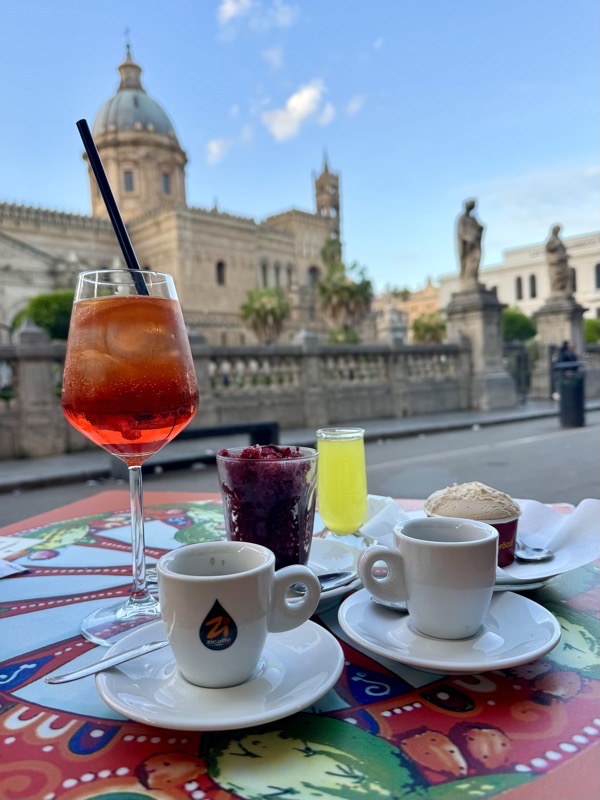
Back to wandering around Palermo, along Via Vittorio Emanuele.
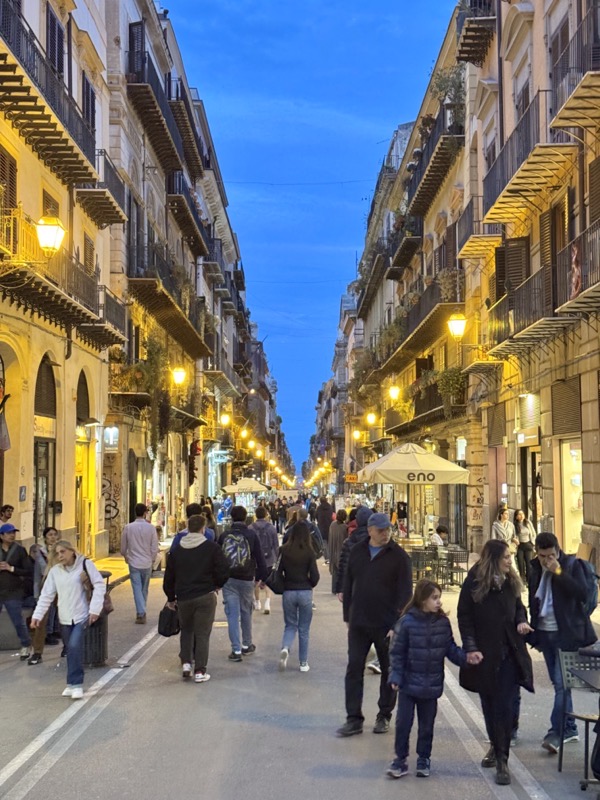
And every door is inviting. Wish the time slowed down.

Sicilian classic — bright and yellow. And lemons are here everywhere — pottery, textiles, restaurant decorations, jewelry, food.
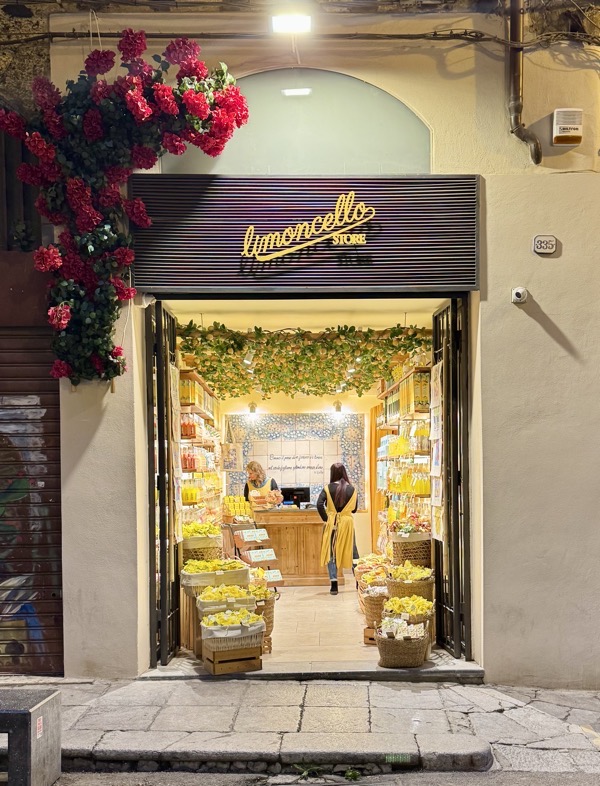
Yes, you can watch this forever…

On our way to the Marina, more modern area of Palermo.

It was getting dark and we were anticipating the arrival of our daughter — the main reason that brought us to Palermo. Charlotte was teaching Italian schoolchildren English.

Little side streets branching off Vittorio Emanuele north and south.
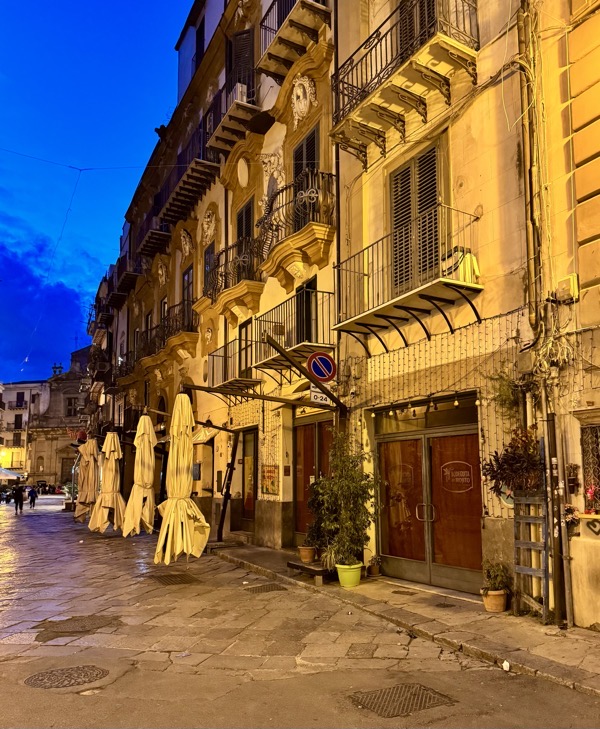
Fontana del Garraffo on Piazza Marina. Its is name derived from the Arabic word that signifies the abundance of water. The piazza is empty now but during the day these trees create a nice spot to pause here with a drink or a snack.
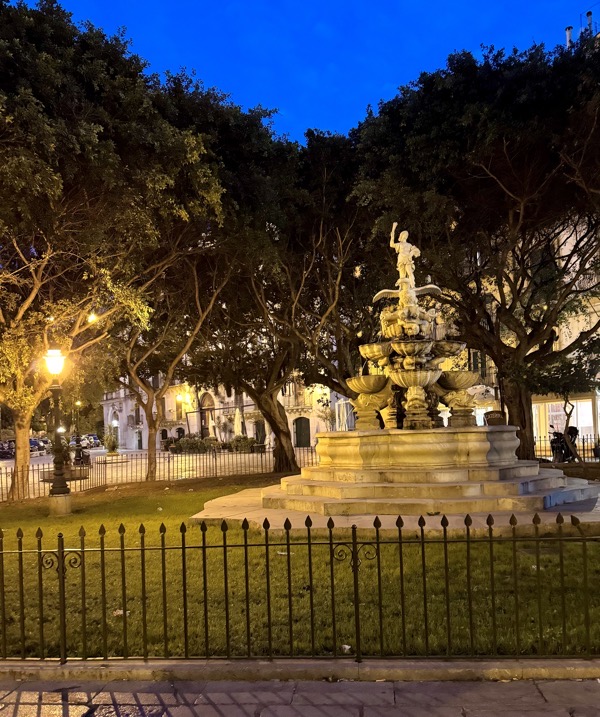
The last stretch before the Palermo Marina.
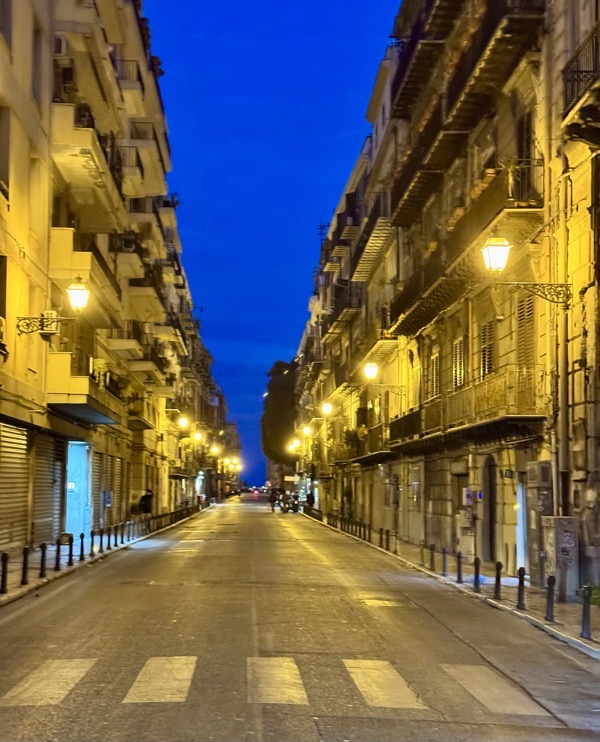
And a turn onto di Porto Salvo towards the bay.

The Church of Santa Maria della Catena, Saint Mary of the Chain, near the port of Cala, is so named after the large chain here that used to block access to the port.

A very busy — even during late hours — Via Cala runs around the bay in a semicircle.
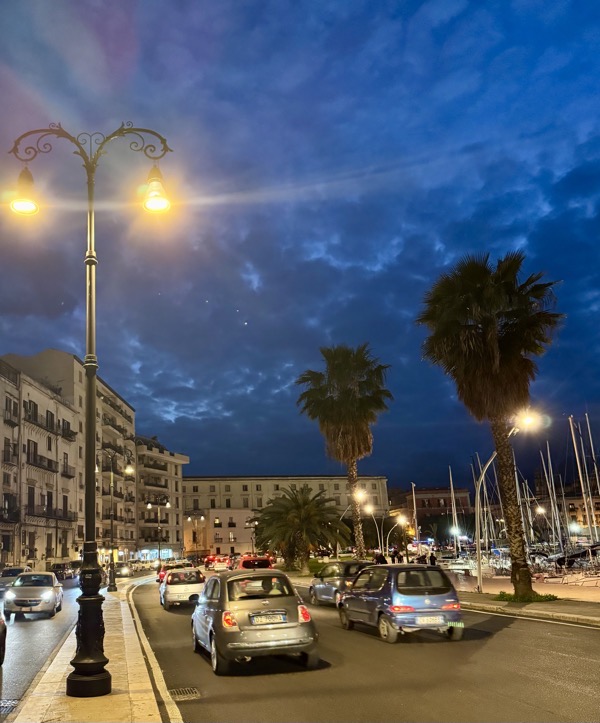
Everything looked more modern and better kept in this area of the city.
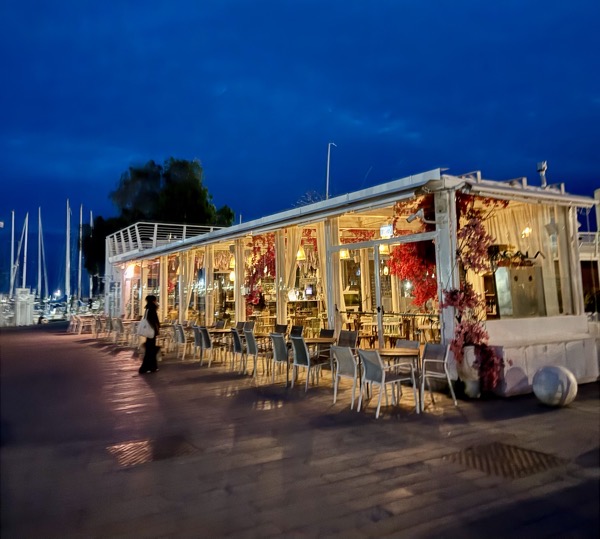
For obvious reasons, I had to single out and take a picture of the Bianca boat.
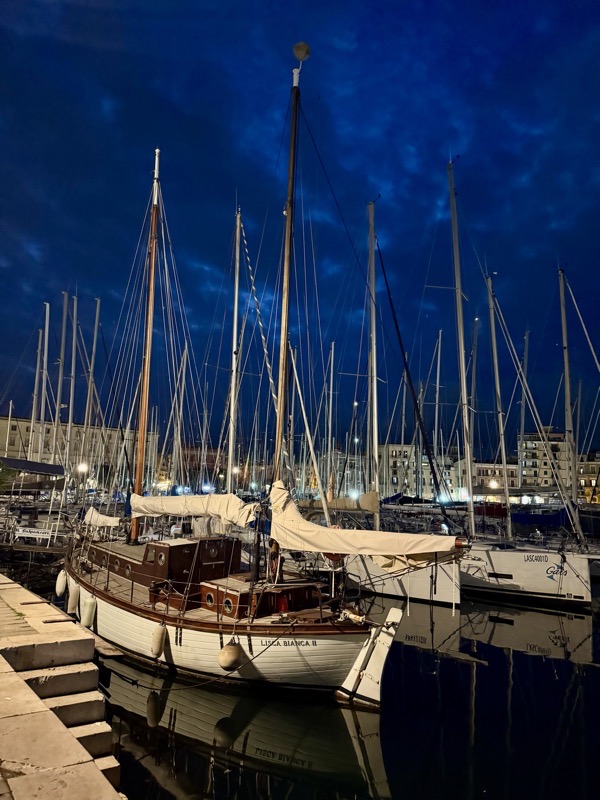
Fontana Danzante Musicale Marina is the largest musical fountain in Italy. They play famous music hits while synchronized dancing water and lights welcomes people arriving into the port. We were greeted by Queen and Pink Floyd.
White Ape Car, a symbol of a compact three-wheel Tuk-Tuk Ape Taxi that takes tourists through the narrow alleys of the town. The only analogy that comes to mind are the New York City horse carriages congregating near the Central Park.
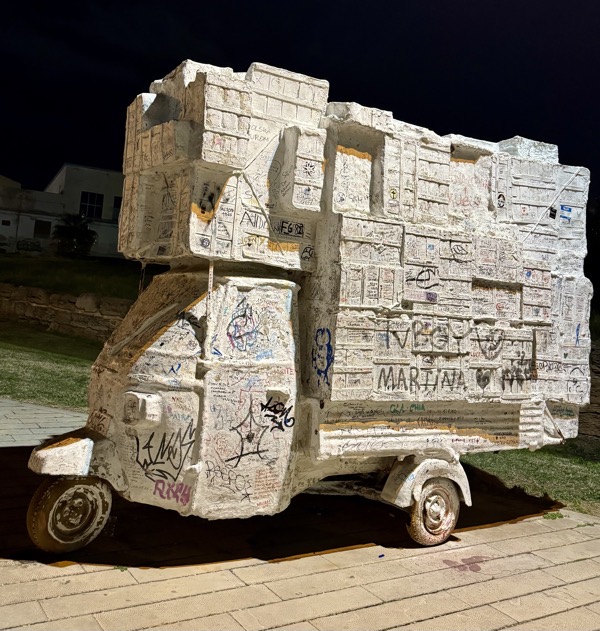
Parents patiently awaiting the arrival of their child.
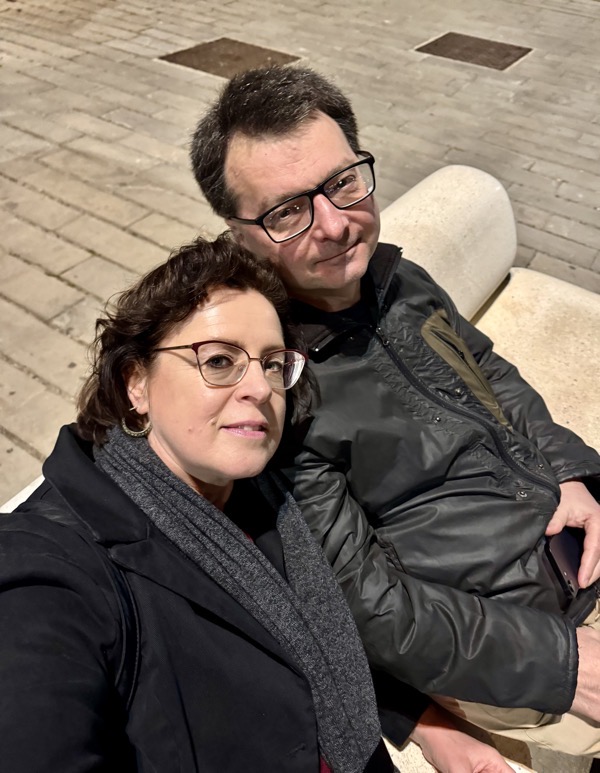
And here she comes!
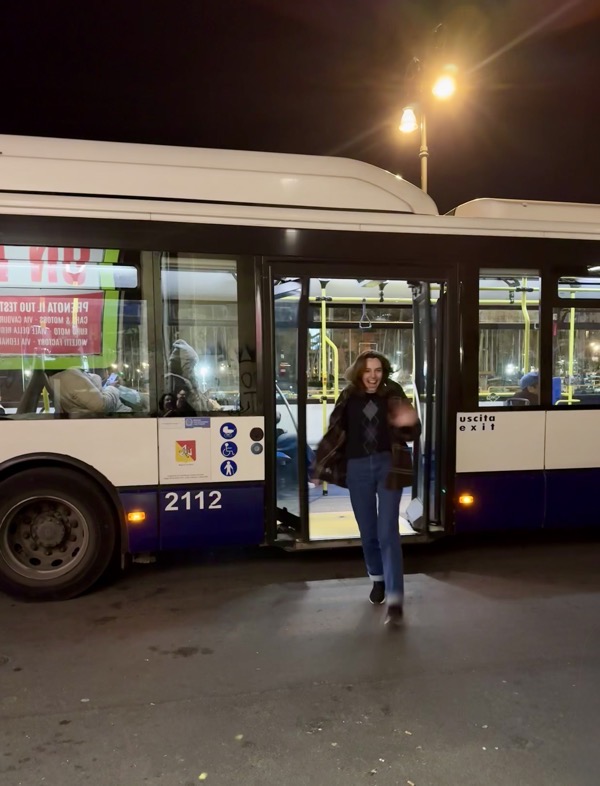
And all the stories!
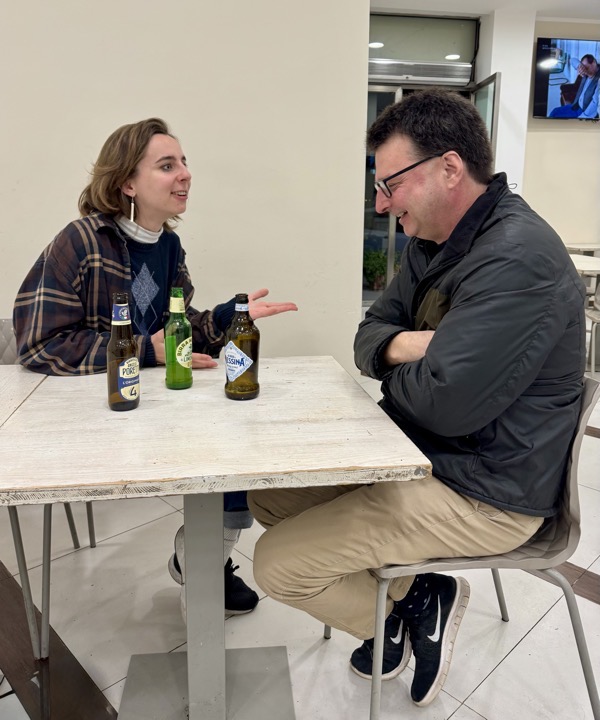
And a little slice of pizza with some birra because the night is young.
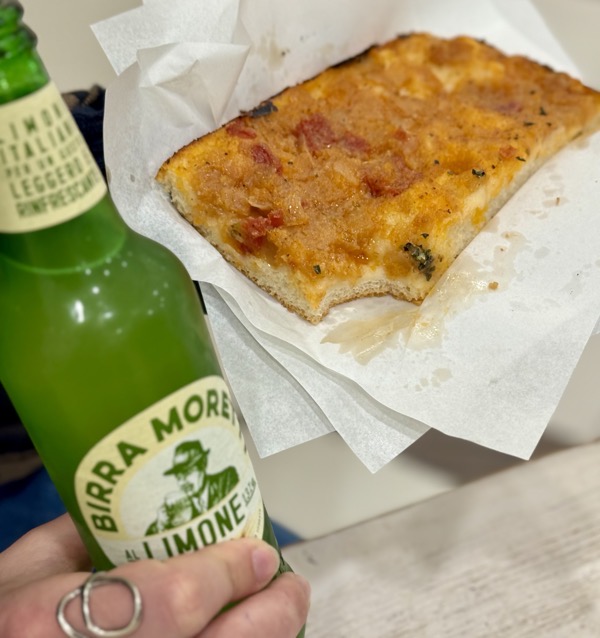
Fortified, we headed back towards our Sicilian home in Vucciria Market
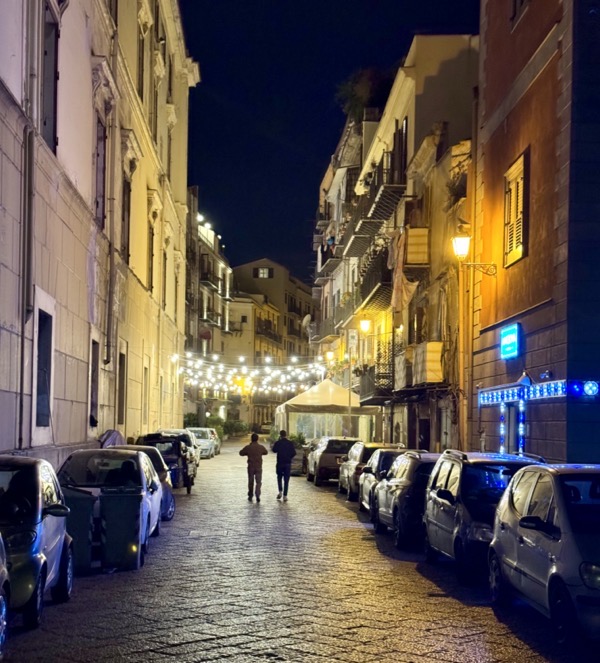
As always, I was lagging behind taking pictures.
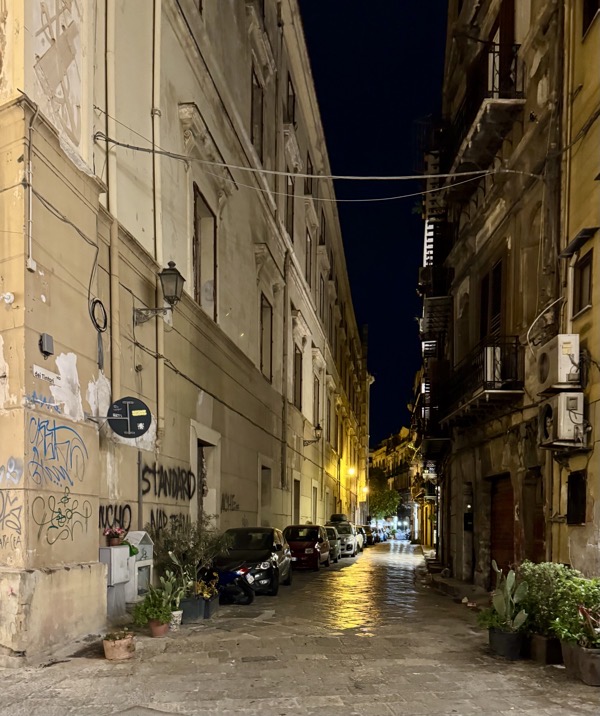
No matter where you look, at every turn, there was something that had to be captured. Like this little art exhibit.
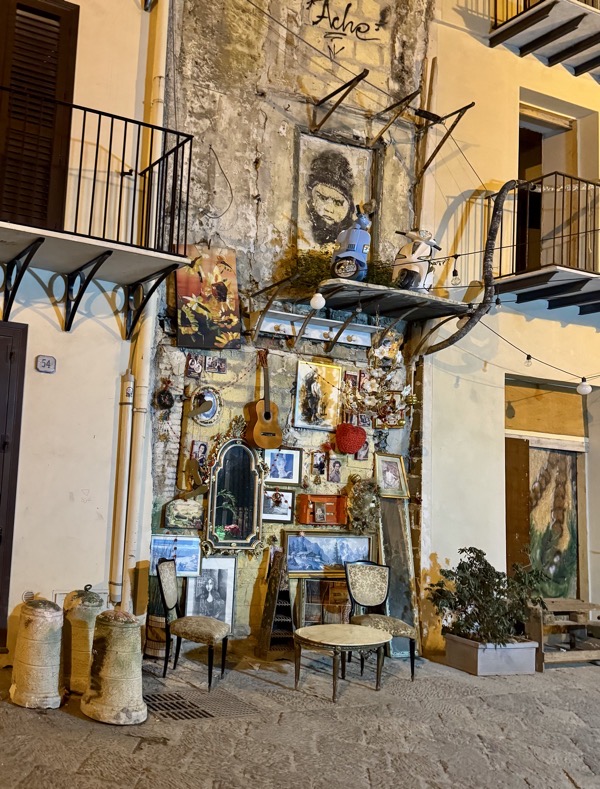
Fontana del Garraffello, a little but interesting fountain that has been here for the last five centuries. Back in the day, its water was considered to have healing powers and people were coming here from far and wide. Unfortunately, the piazza around it is out of repair even though the crumbling walls around still look attractive.
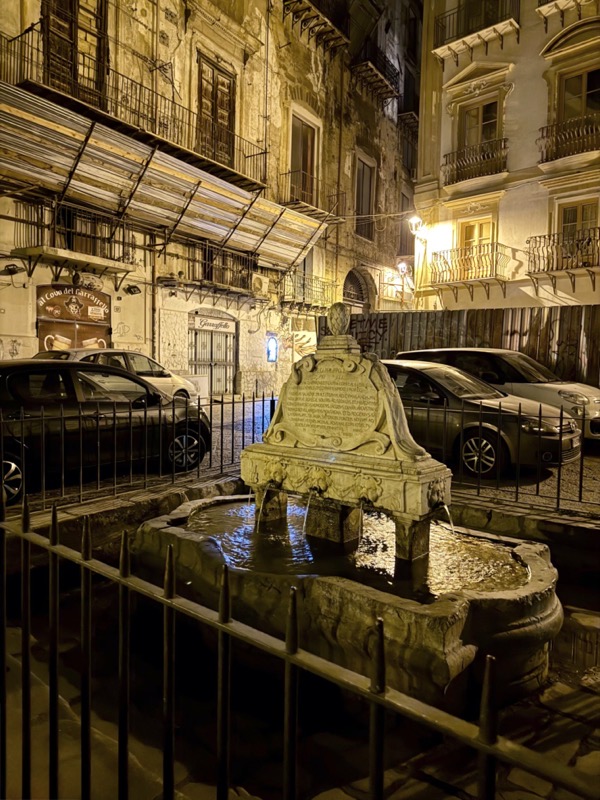
Sicilian mafia in decline but the street art portraying it is on the rise. This stencil portrait of Marlon Brando as Vito Corleone from The Godfather was created here by a French artist known as C215.
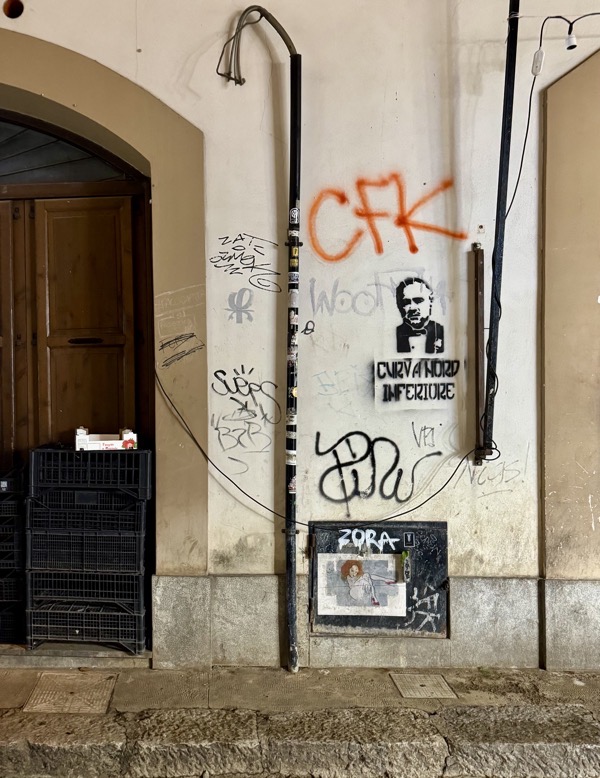
La Piazza Caracciolo in the historic center of Palermo and the heart of Vucciria market. During the day it is filled with vendors. At night, it becomes a hangout for local music artists and dancing.
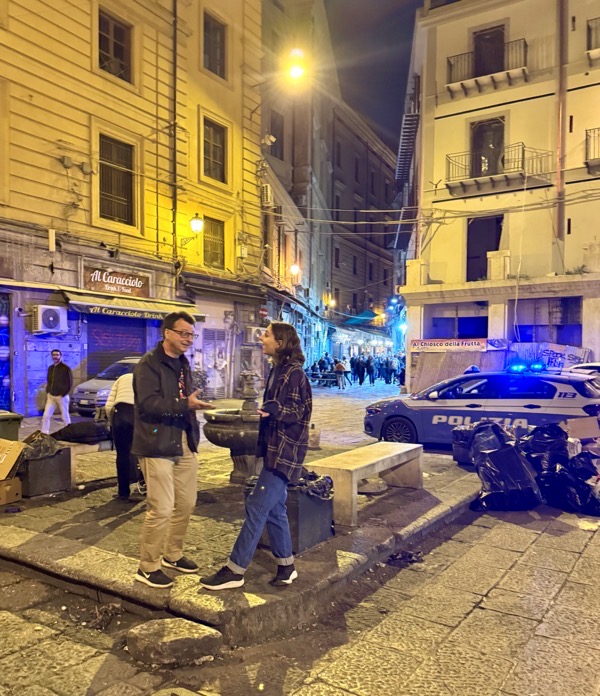
That is Via Maccheronai, which is part of Vucciria market on a Sunday night in March. On the right and left, this street is adorned by seating areas of bars and restaurants. As you walk, calls are coming from either side luring you in.
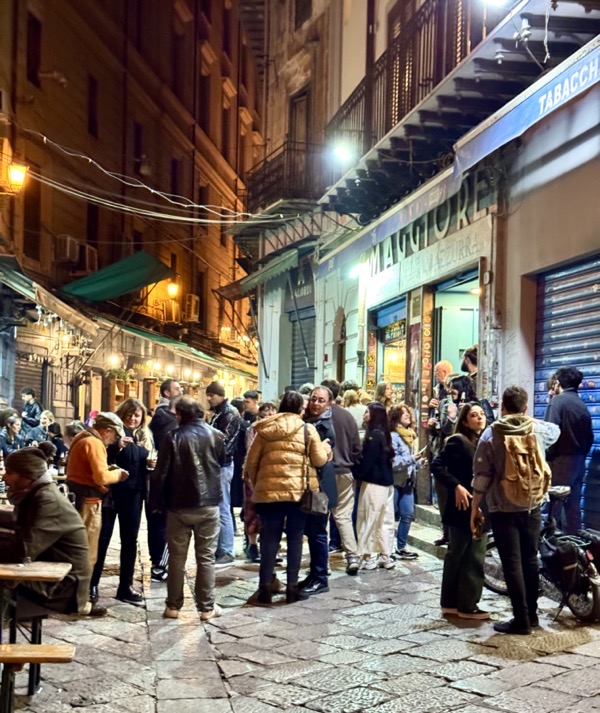
The view from our room to the market was much more subdued on a Sunday night than the night before. Honestly, I was kind of disappointed as I was ready to go out and party.
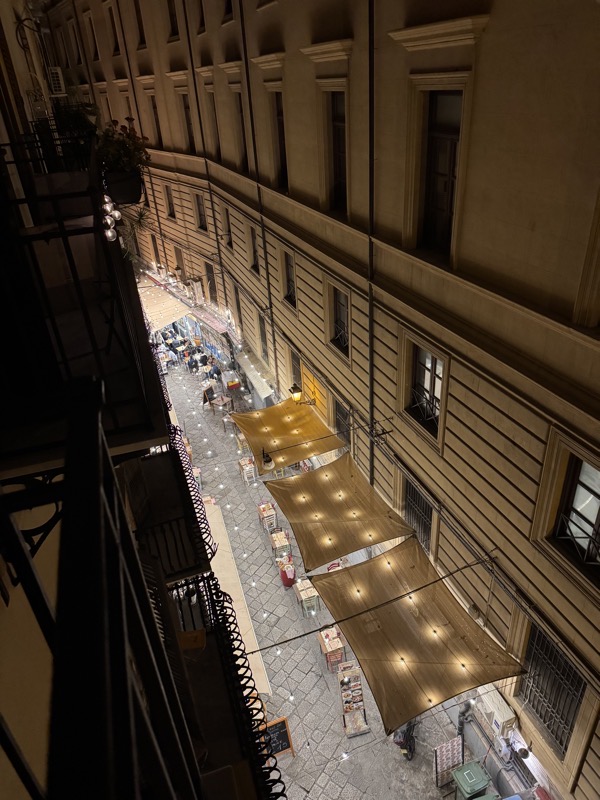
Night view from our balcony towards the Colonna dell’Immacolata on Piazza San Domenico.
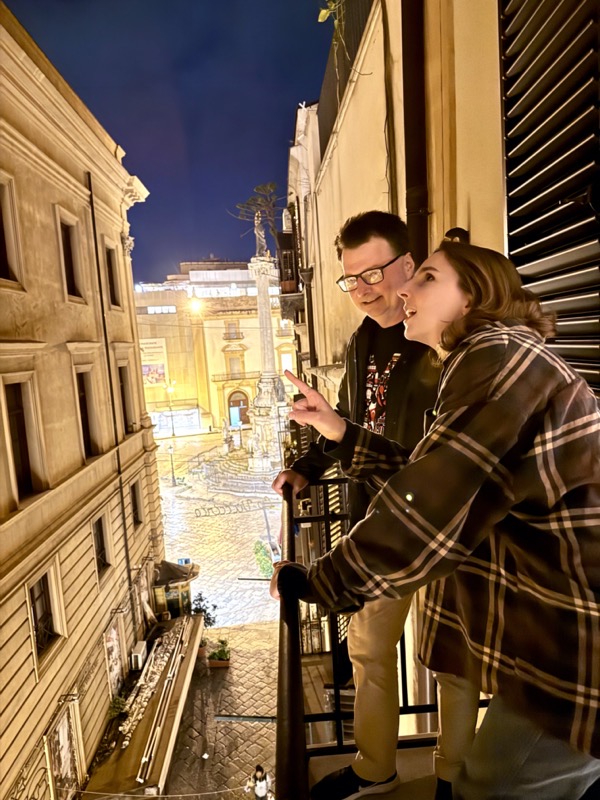
Once we showed Charlotte our impressive Palermo digs we went right back to my favorite people watching place from the last night Taverna Ceslo.
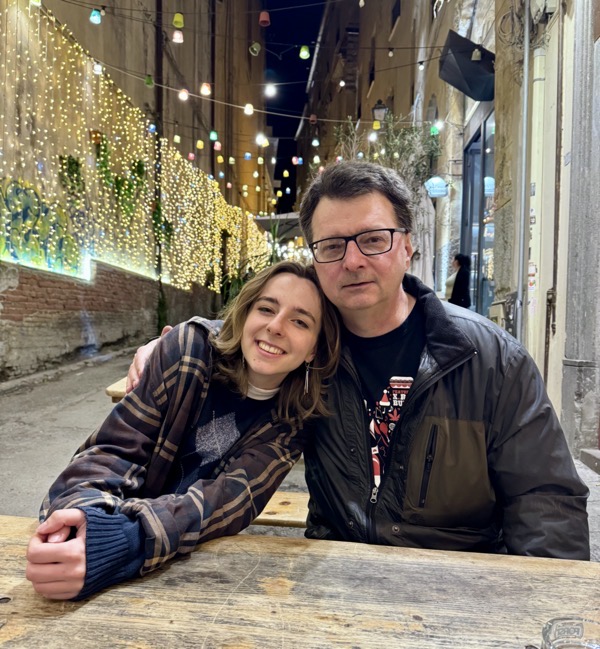
This time we realized that besides drink you can also order food here. Another Taglieri di Salumi & Formaggi felt just right. Although, I have to tell you, they took the time assembling it.
No matter what, this kind of platter will never feel boring for me.
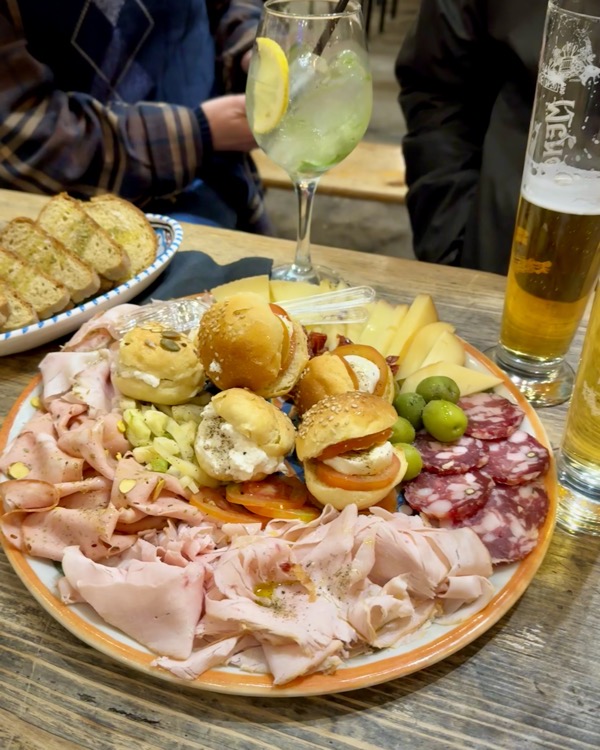
That night, the place seemed much more quiet than yesterday. Probably because it was a Sunday night and Sicilians were anticipating looming Monday morning.

Back to Quattro Canti on Piazza Vigliena. Also not as busy and chaotic as the night before.
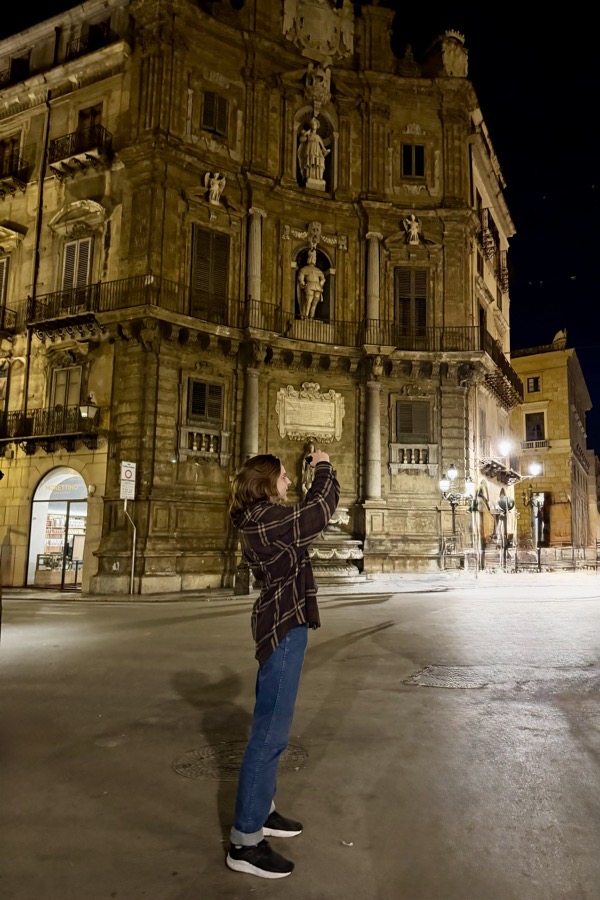
This is Sunday night in March. I can only imagine how mobbed this place would be on a sunny Saturday afternoon in summer months.
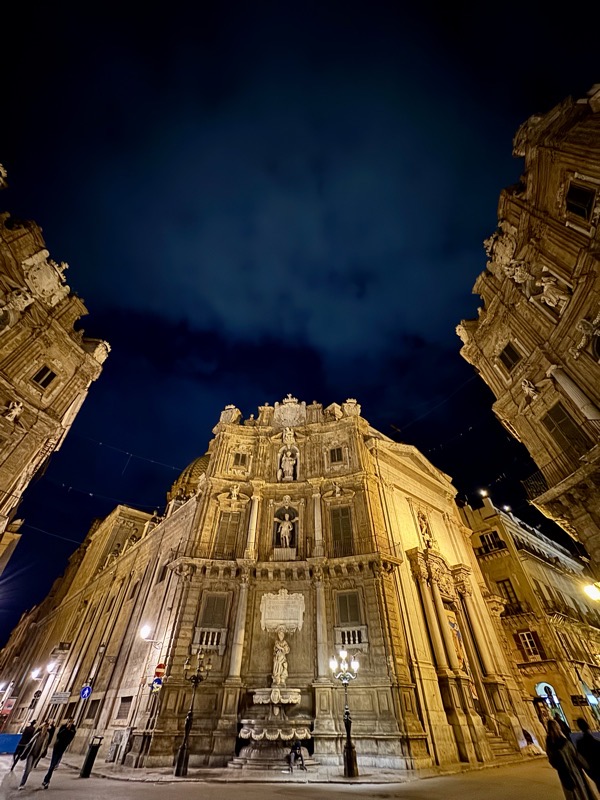
From the Square of Four Corners, we moved along Via Maqueda towards Charlotte’s bus stop. Tomorrow was another work day for her, too.
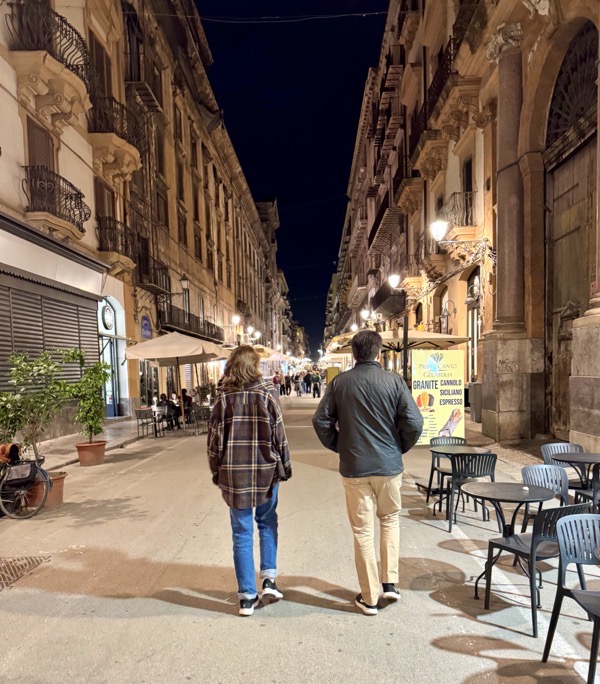
On a Sunday night everything was closing much earlier than the night before.

And there was plenty of seating available in the restaurants lining up the street.
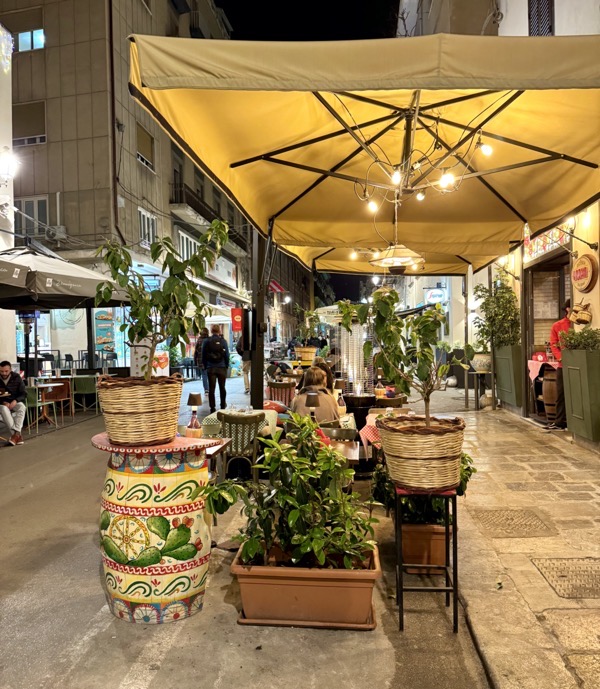
Massimo Theater from the front in the dark looks even more magnificent than during the day.
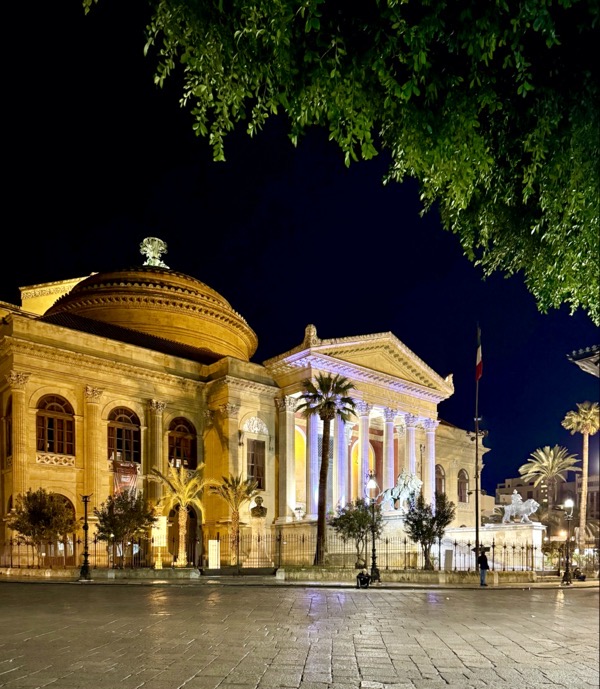
Little independent Charlotte gets on the bus and goes to her Sicilian home. Amazing how the baby of the family in an alien country, all by herself, and she knows where the bus stops, and what bus to take, and where to get off. And all by herself!
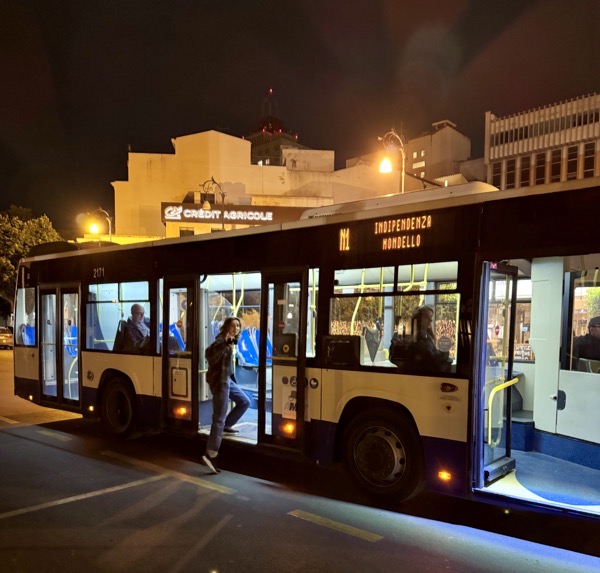
We continued back towards our hotel where we were supposed to meet our other child, Lizzie, who was flying through Belgium. Also independently. Will I ever get used to that?
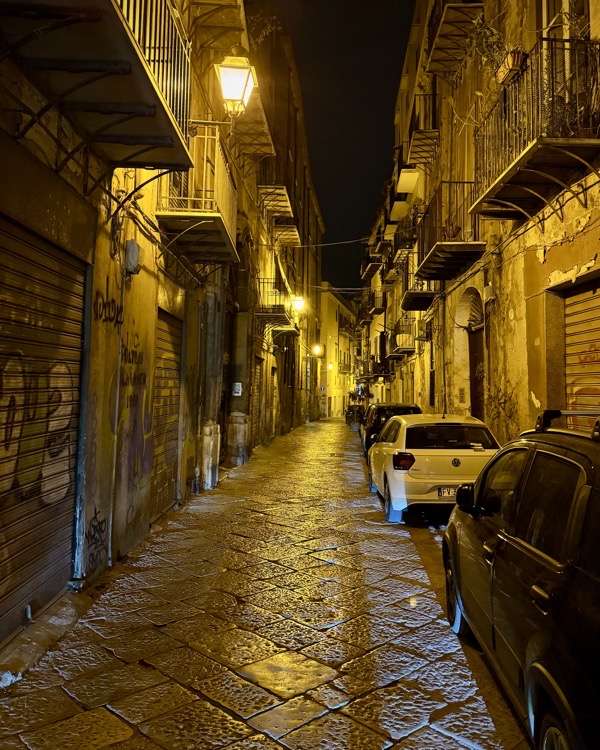
International sign on the wall. Of course we stopped to support their business.
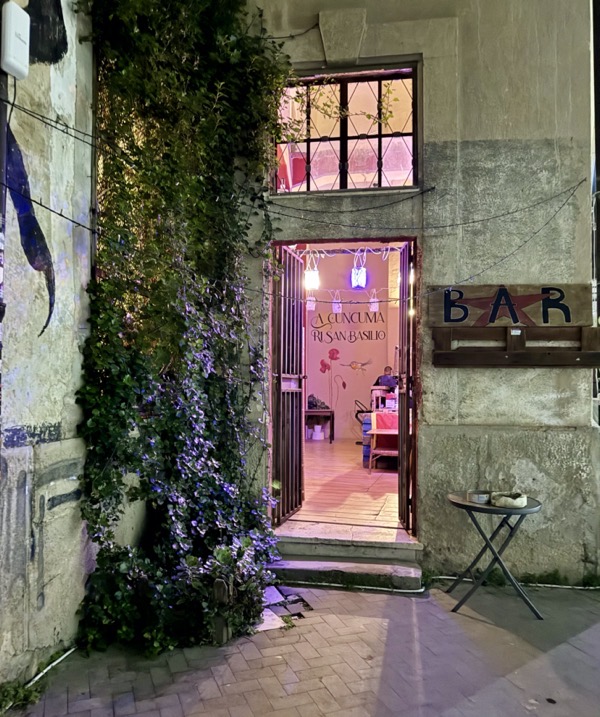
The night was young, we were jet lagged and awake. Lizzie was on her way from Belgium and we had to stay up to meet her.
The arch with these unusual graffiti got our attention and we walked right in.
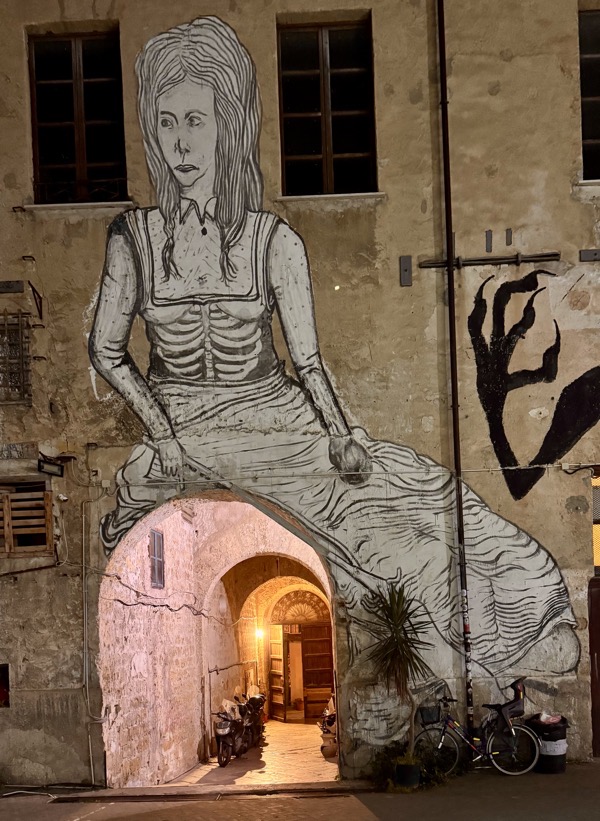
One of the versions of Trinacria, the symbol of Sicily, was next to the woman lifting skirt over the arch.
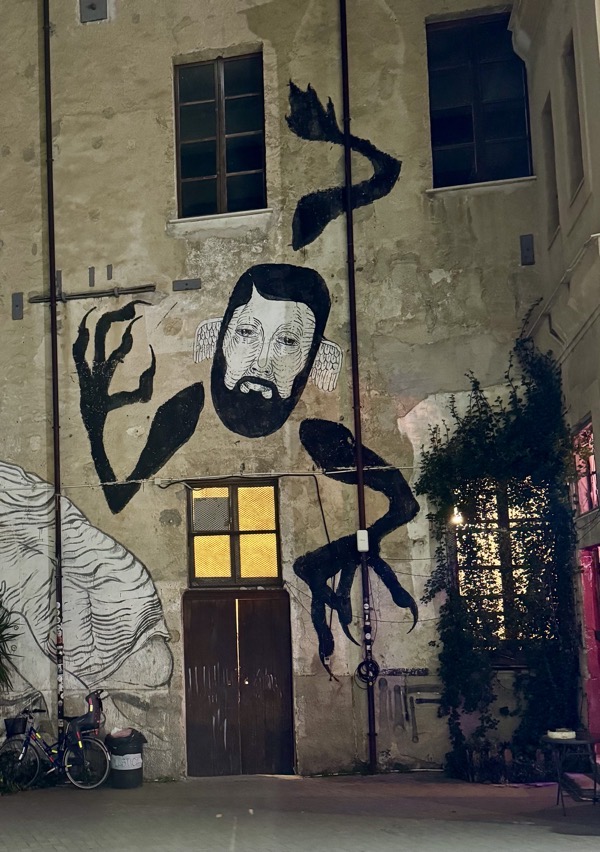
More graffiti inside the little empty piazza.
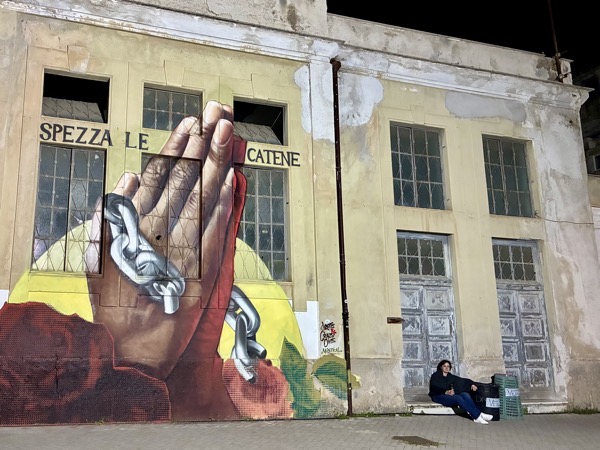
The inside lights of the building were lit and through the crack in the door we noticed some sort of gathering inside. In library-looking room, there were people of all ages sitting on the chairs lined up amphitheater style.
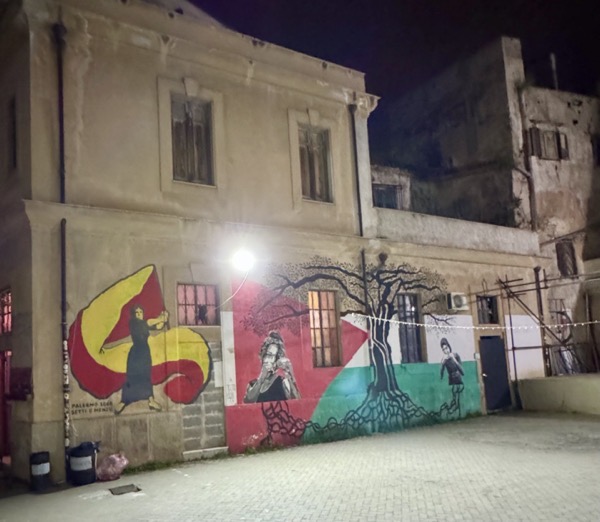
When thee meeting was over and the door opened wide to let the smokers out for a break — yes, the do smoke in Italy more than in the US — people noticed us and waved us in. With the help of hands and some English, we understood that this was a poetry reading gathering.
We looked around for a bit and moved on towards our Sicilian home.
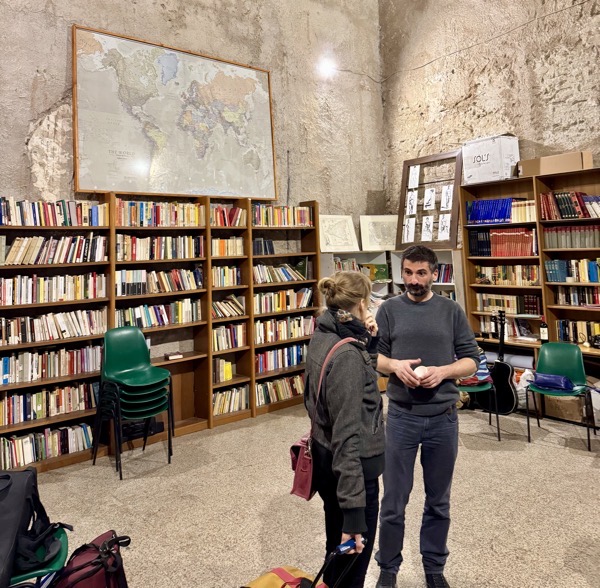
For me, back then, our walks were an absolute Brown motion wandering through the streets. North? South? Main street? Alley? I was blindly following Tom letting emotions and memories quietly take over. Now, looking back through the pictures, it is interesting to follow our routes on the map.
Italy is so present in Russian literature especially that of the 19th century we studied in school. There is so much Sicily in movies — The Godfather, Malena, Cinema Paradiso, The Leopard, Il Postino, L’avventura.
In the 80’s Soviet Union, together with the entire country I was glued to TV following Michele Placido in Damiano Damiani’s La Piovra series about an Italian commissar taking on Sicilian mafia and corruption.
Now memories were falling into real places.
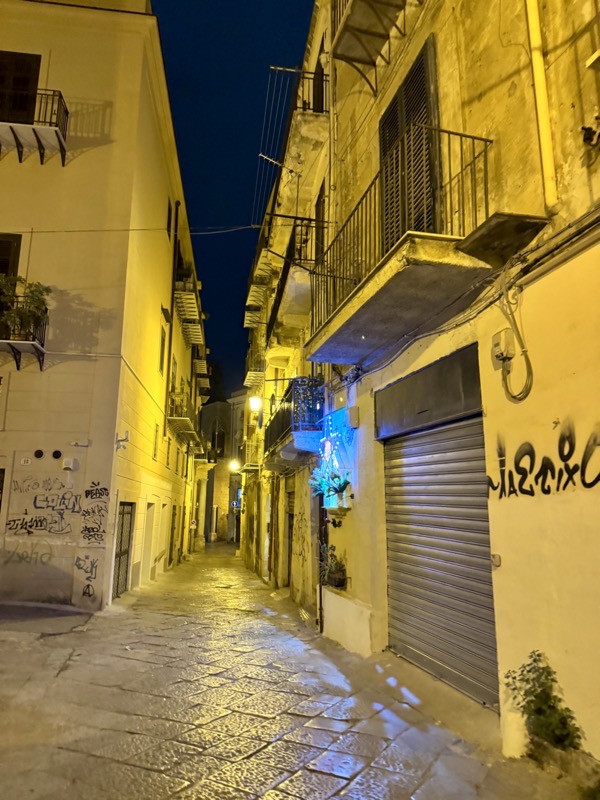
Italian neorealism movement coincided with the younger years of my parents and its message went very much along with the life and mood of the Soviet Union. Visconti, Antonioni, De Sica, Rosselini were very much household names and reached my ears at the age most impressionable. These streets were taking me right back into those times and my parents’ kitchen, where we had a TV and big table that heard so many interesting conversations.
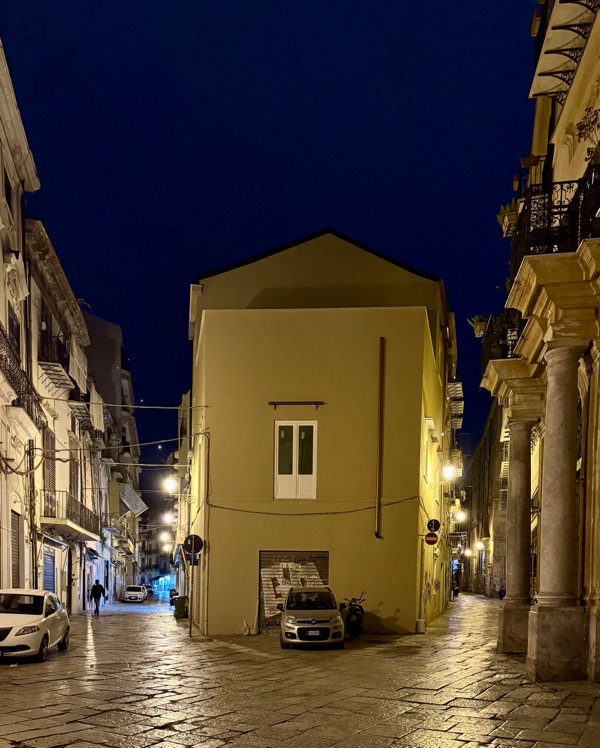
Meanwhile, Tom’s phone indicated that Charlotte safely arrived to her quarters and Lizzie was quickly moving our direction from the airport.
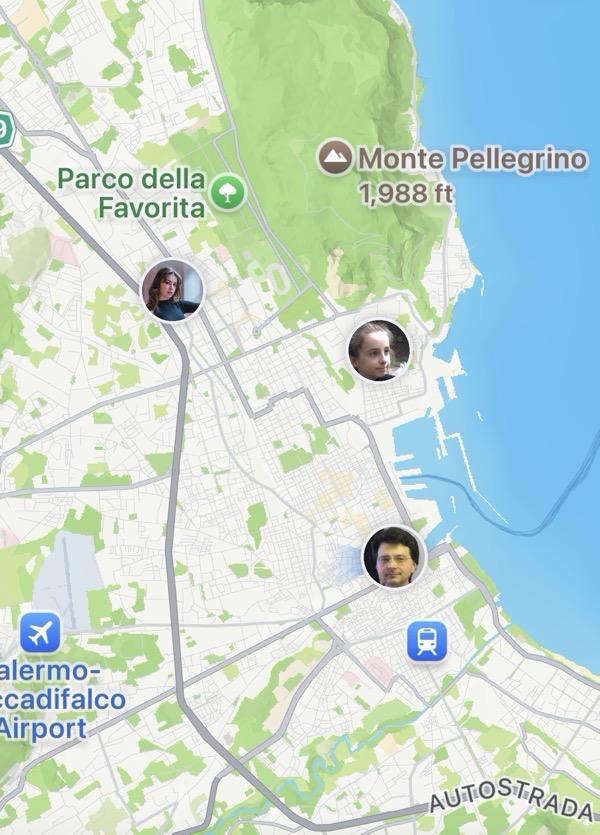
Happy late night reunion by Vucciria market at San Domenico 7.
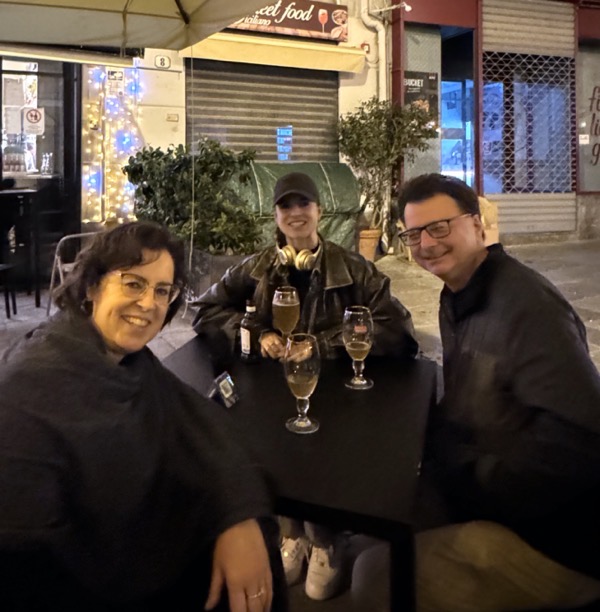
All three of us still jet lagged, we stayed outside and enjoyed the nice weather until the place was about to close.
